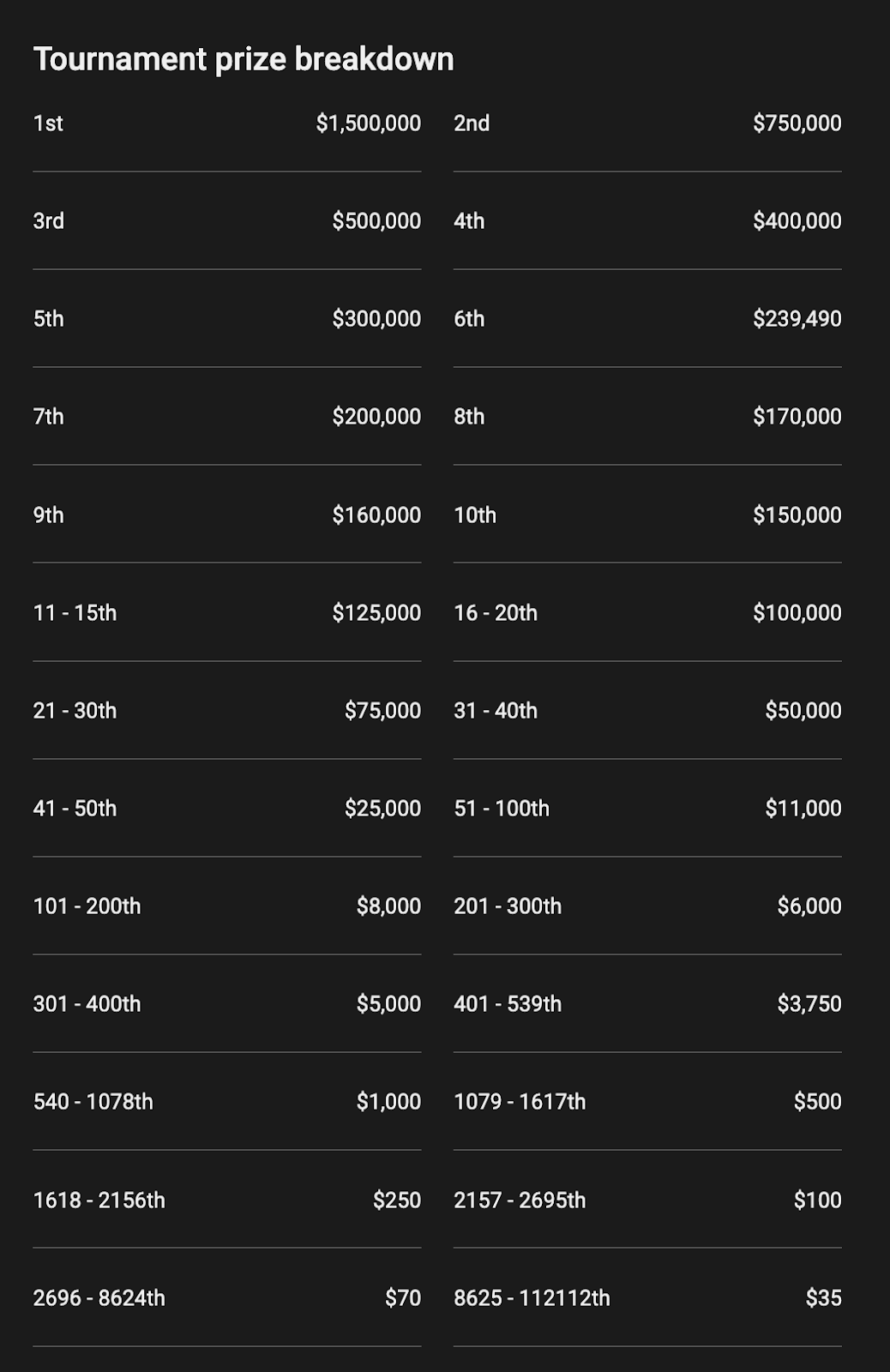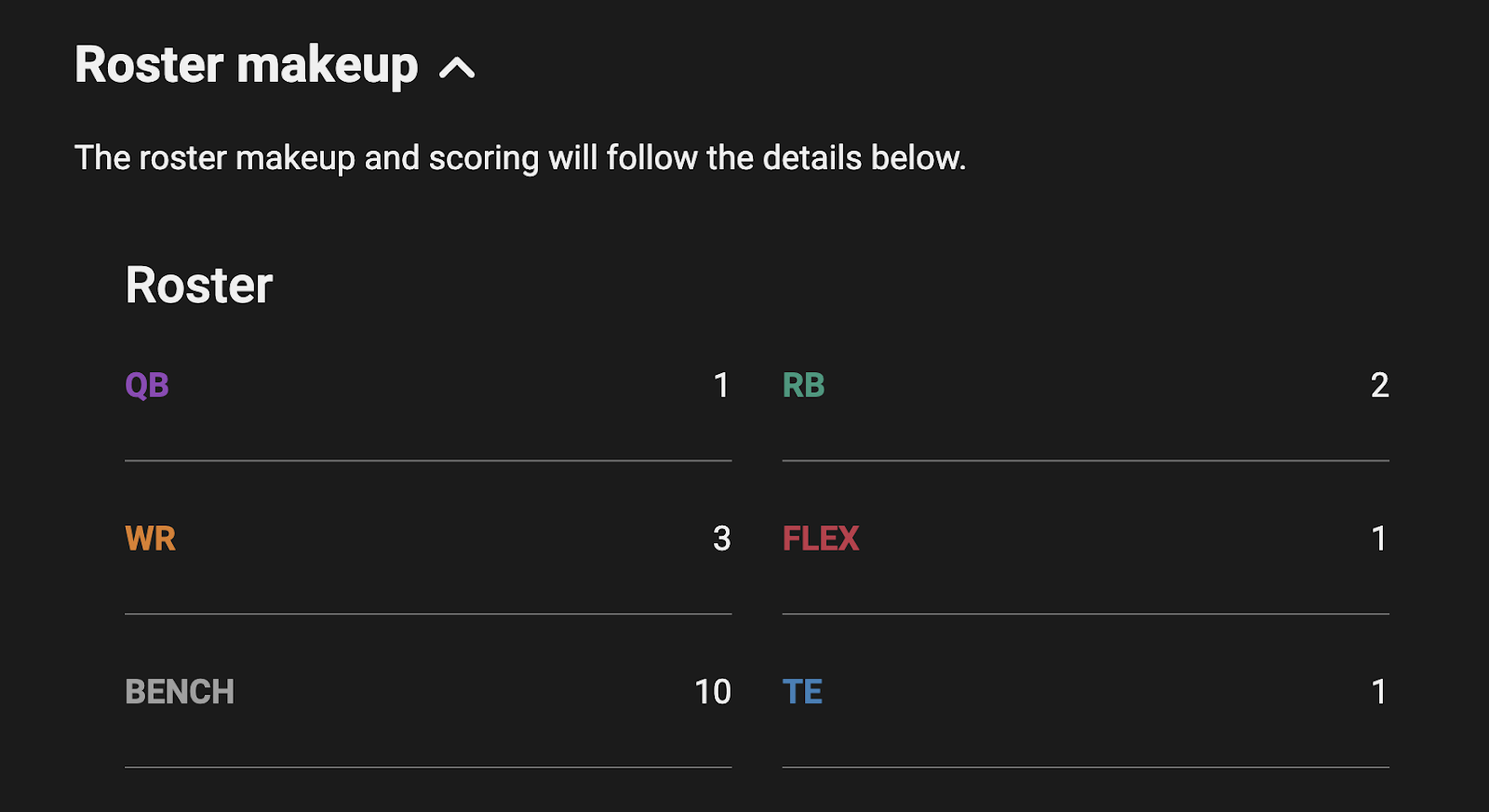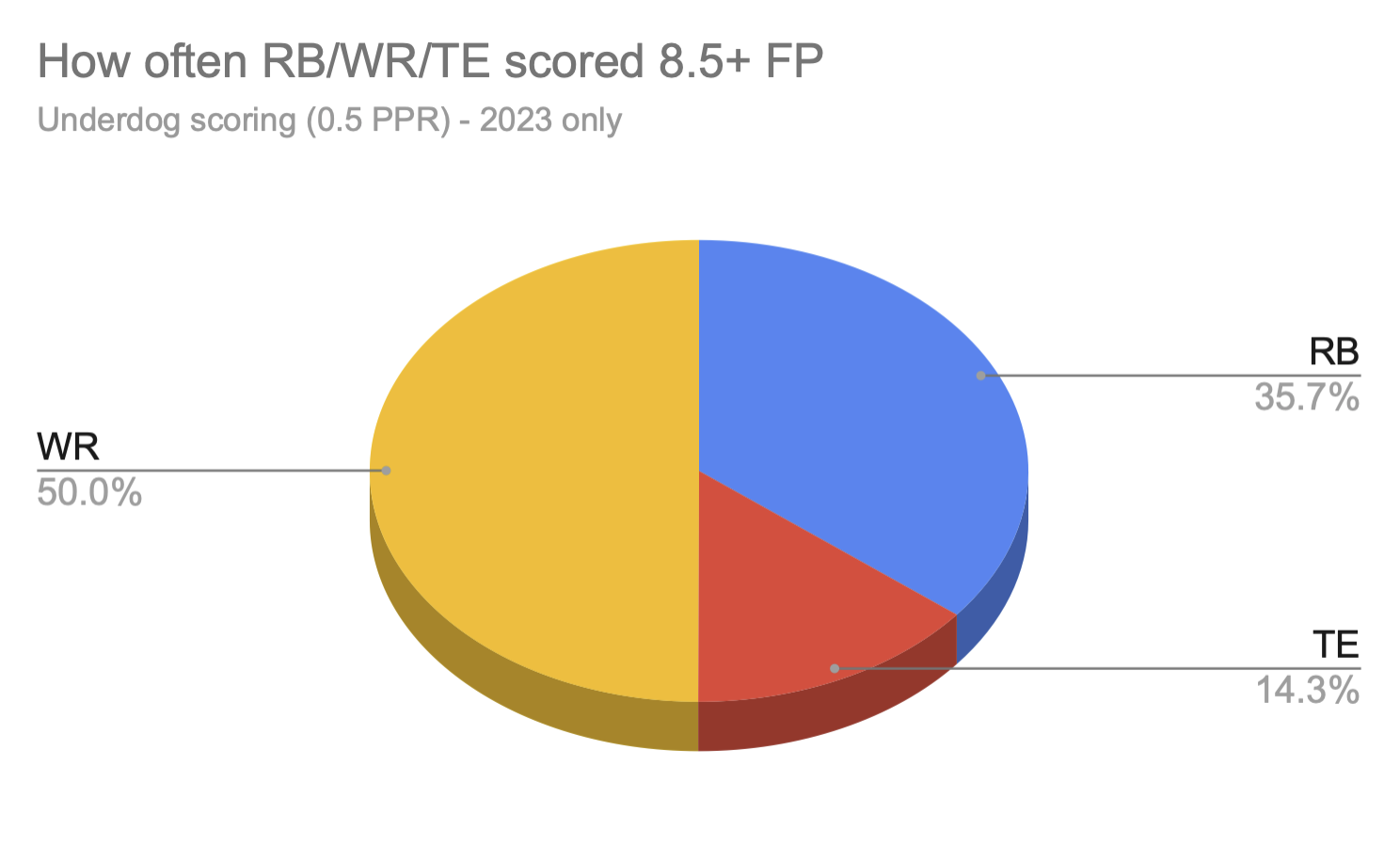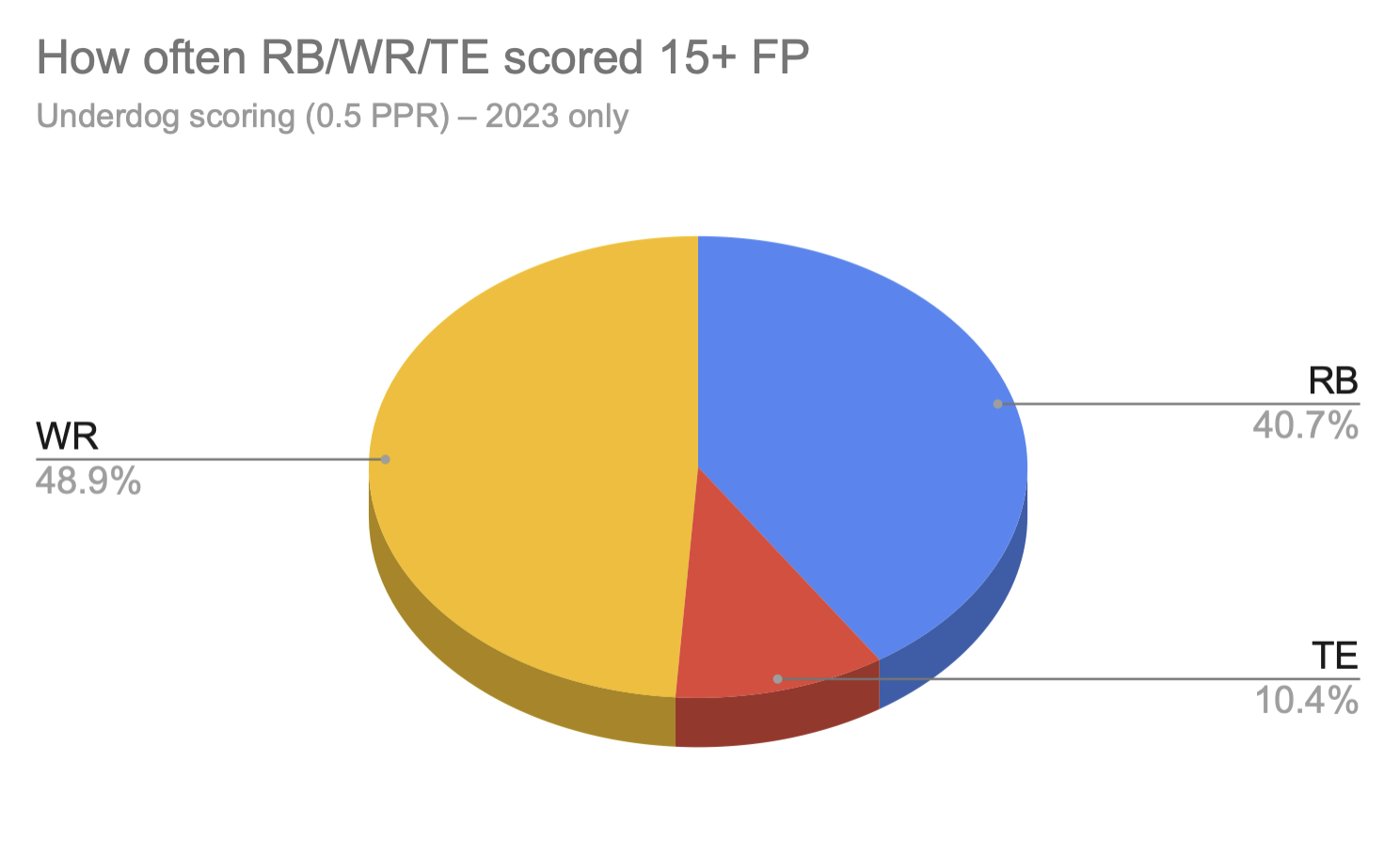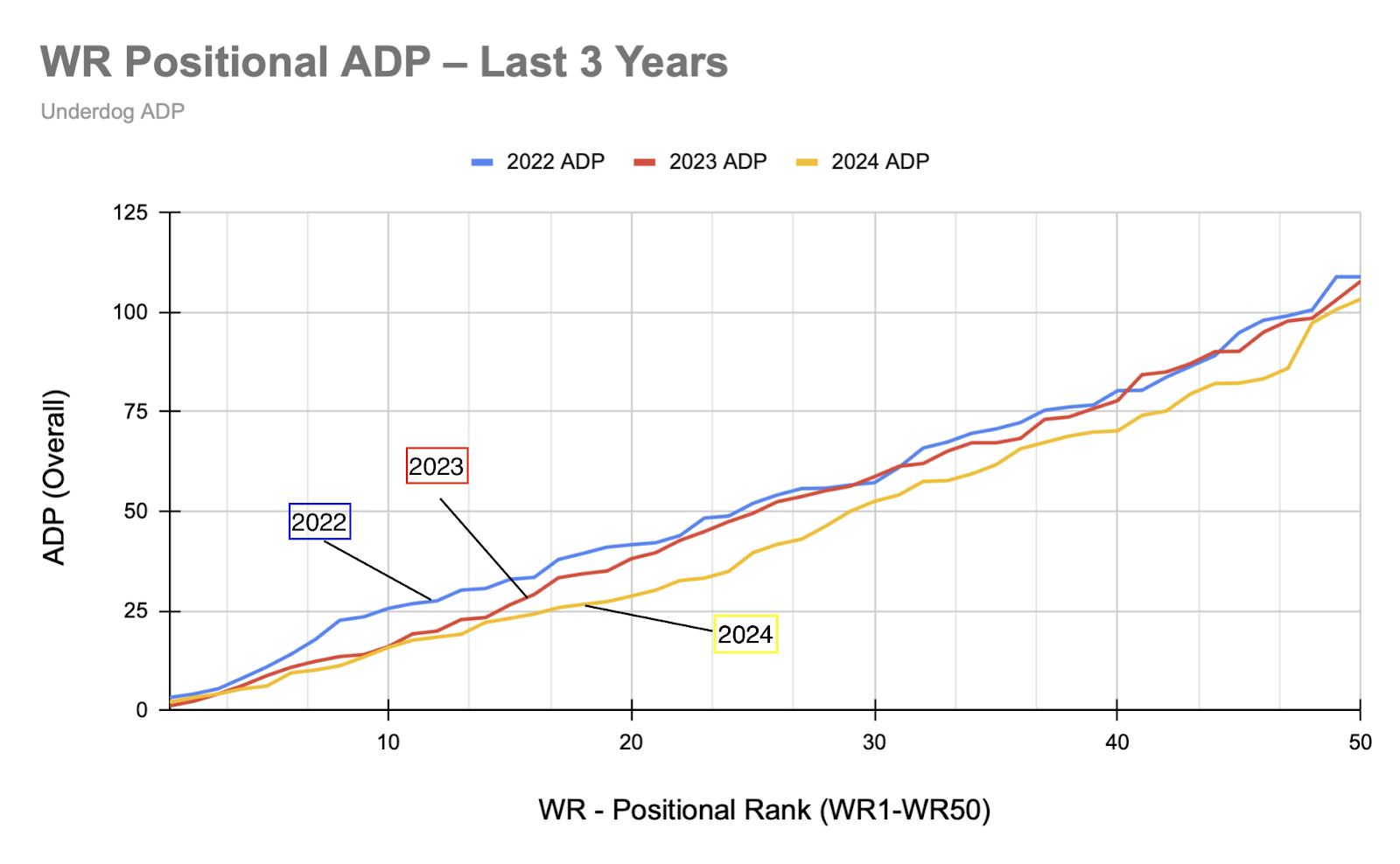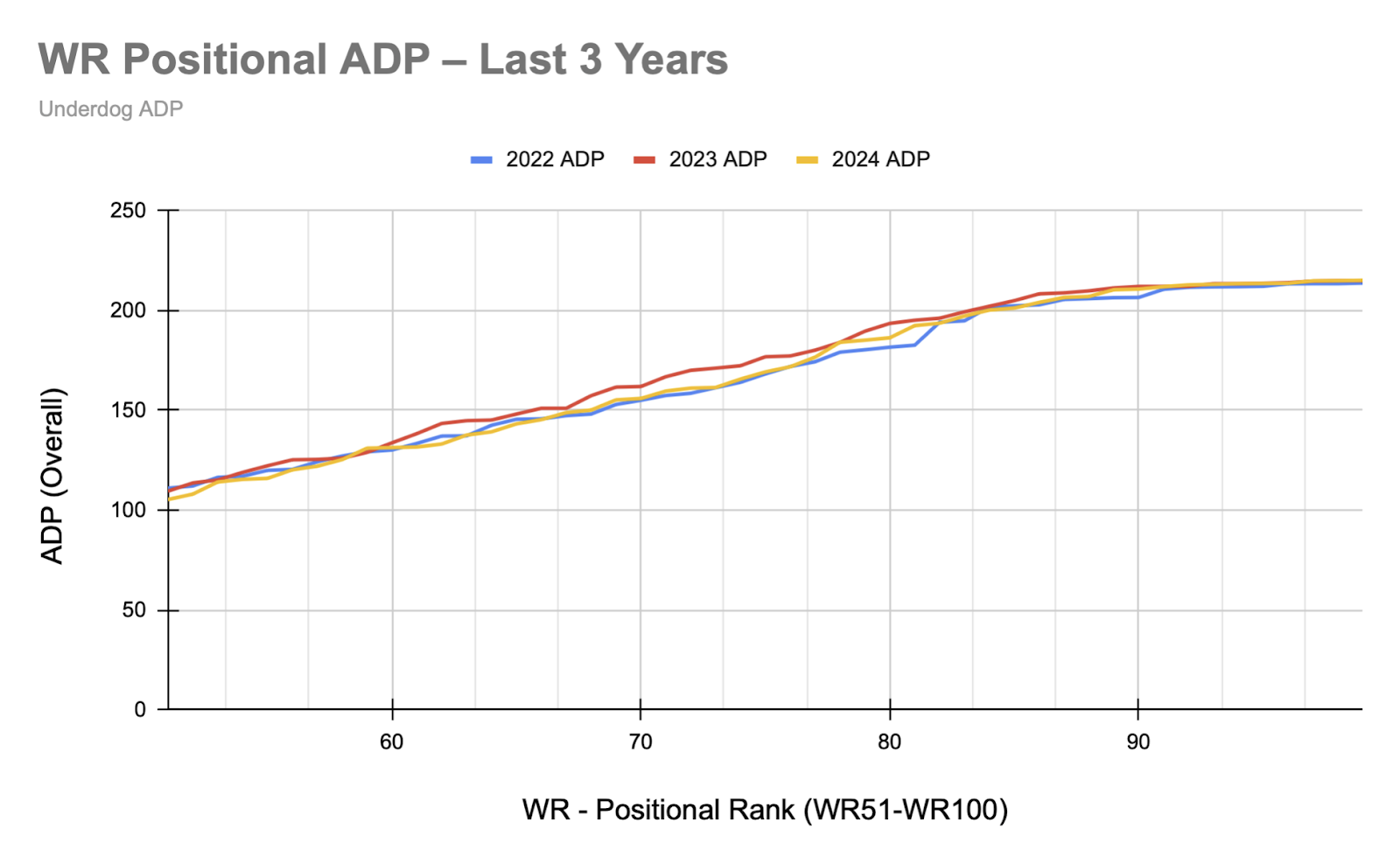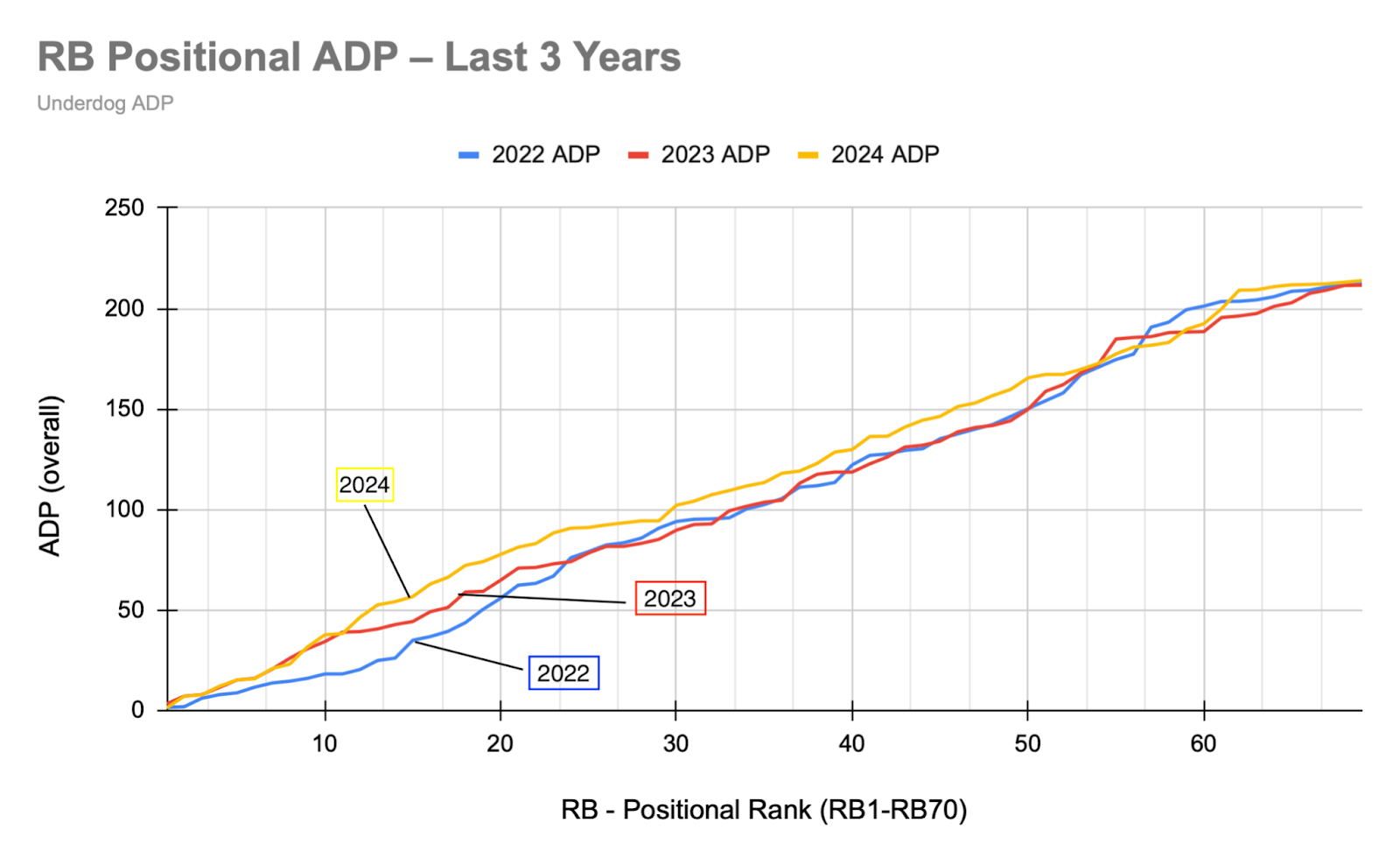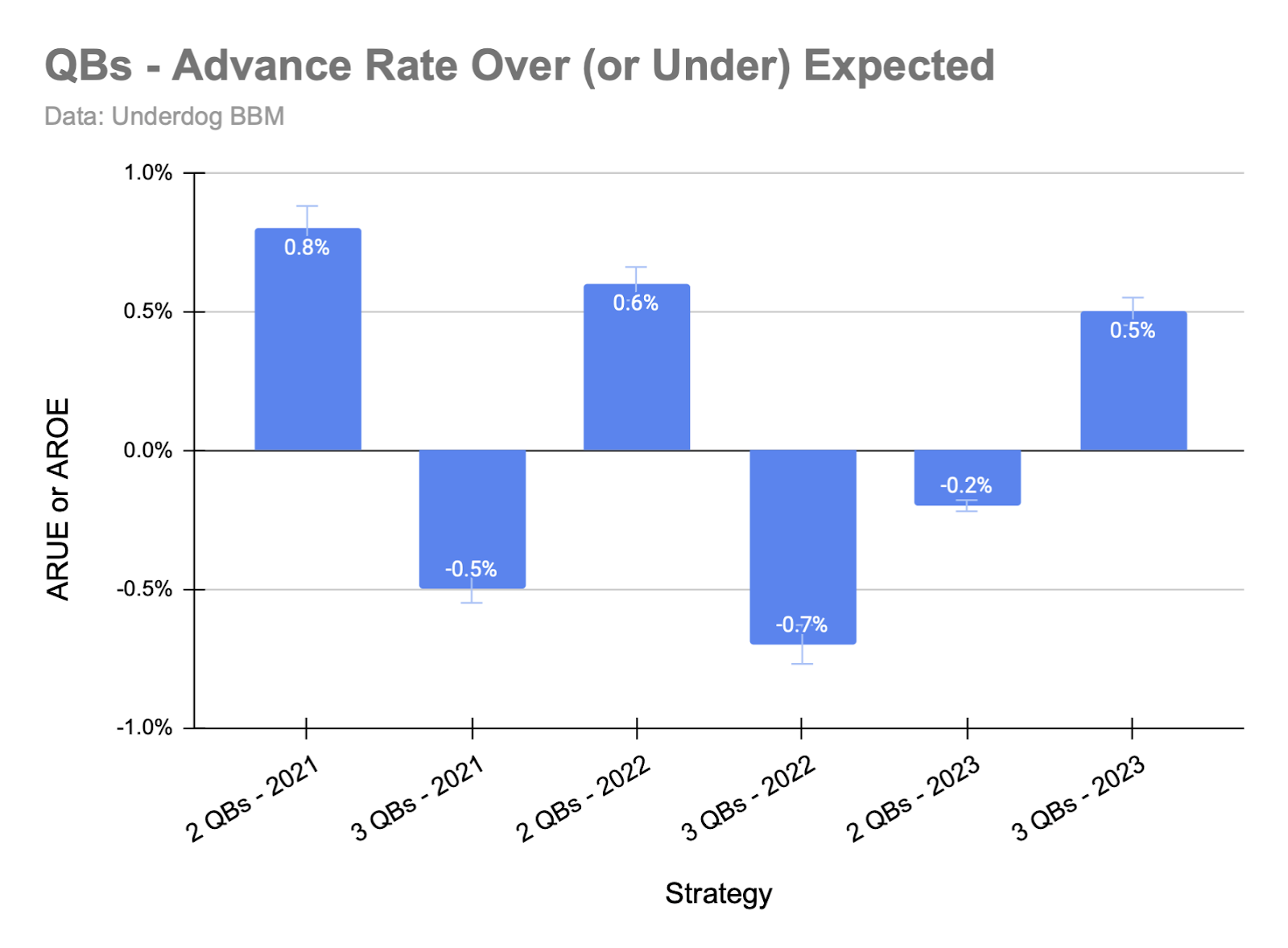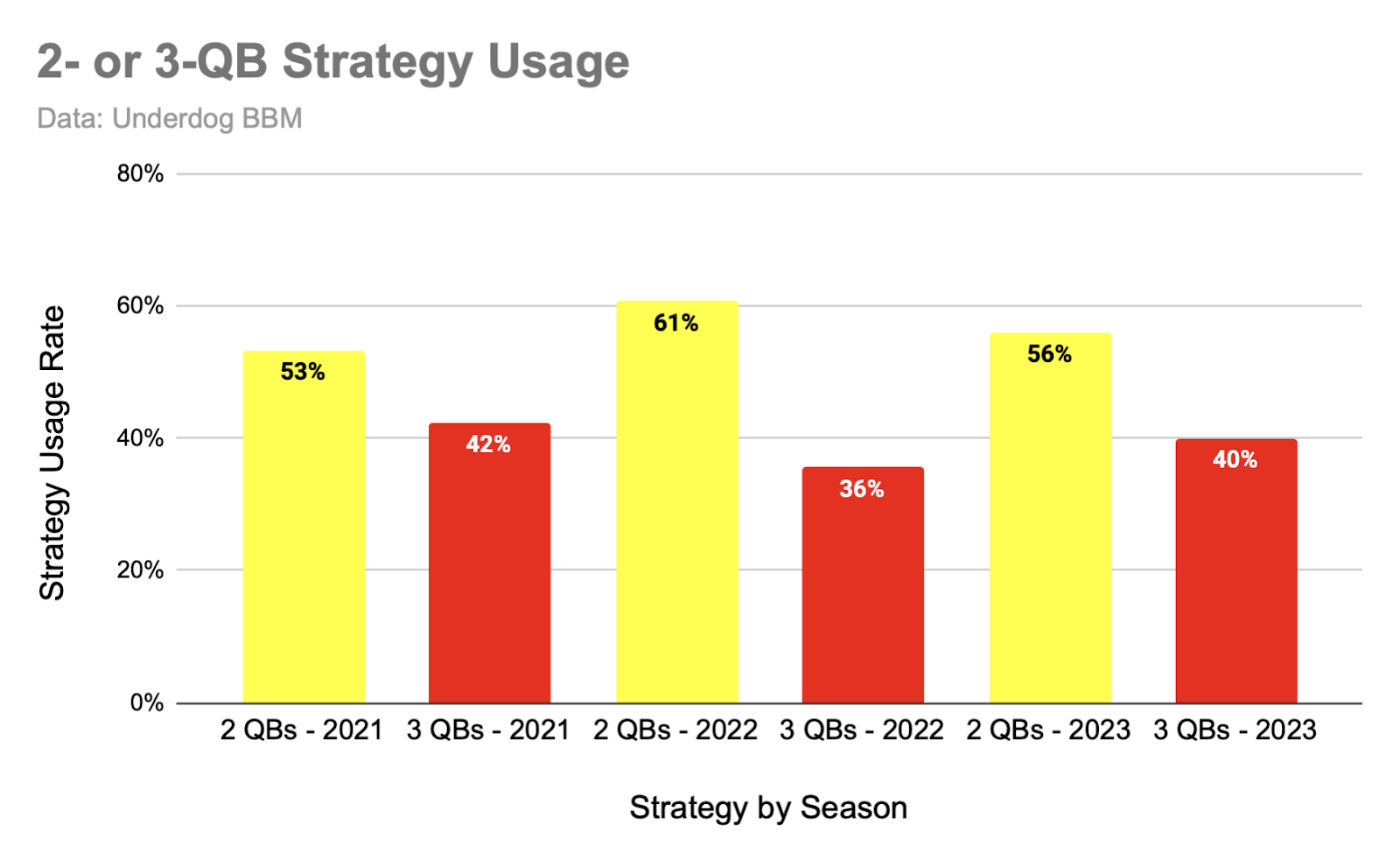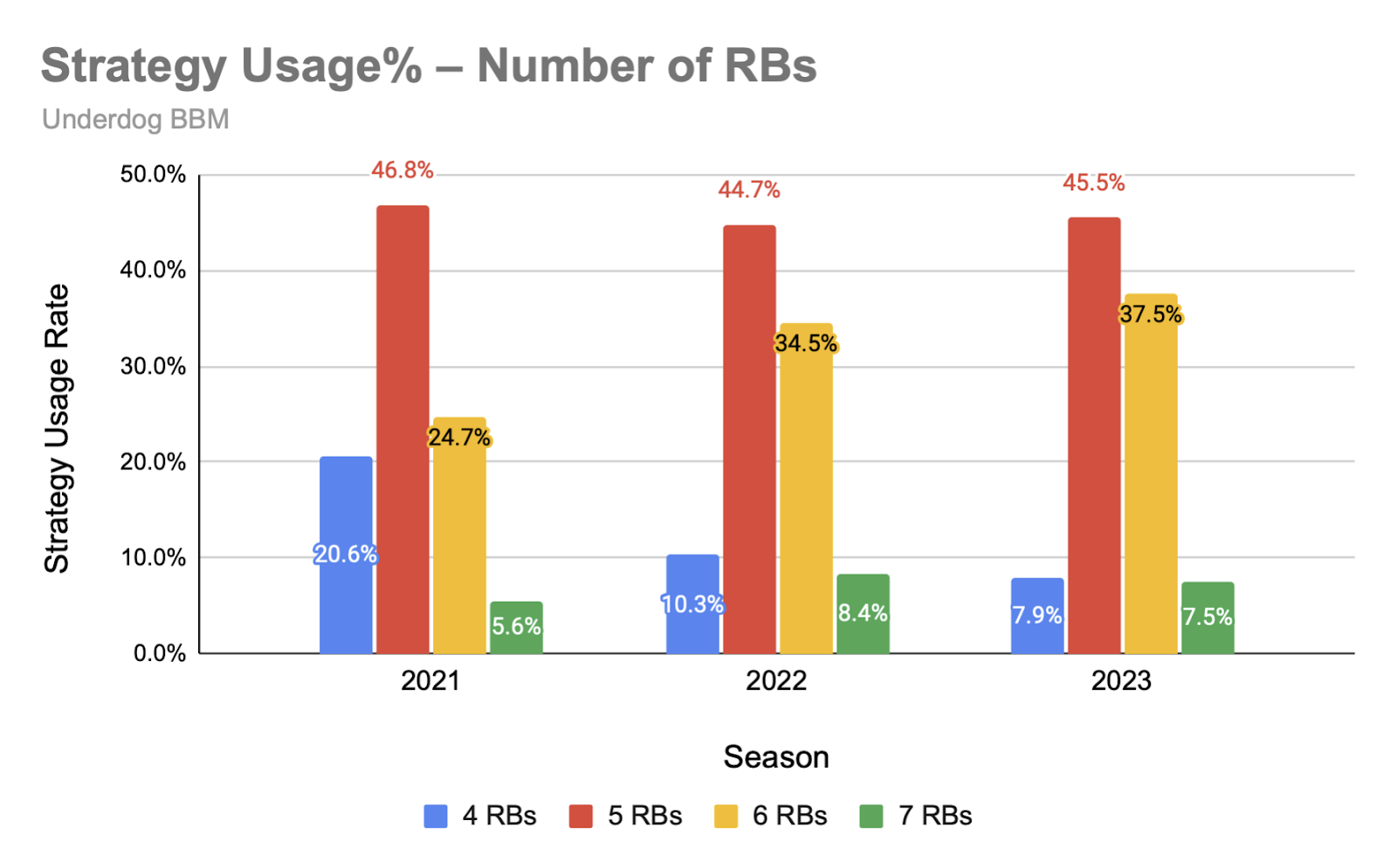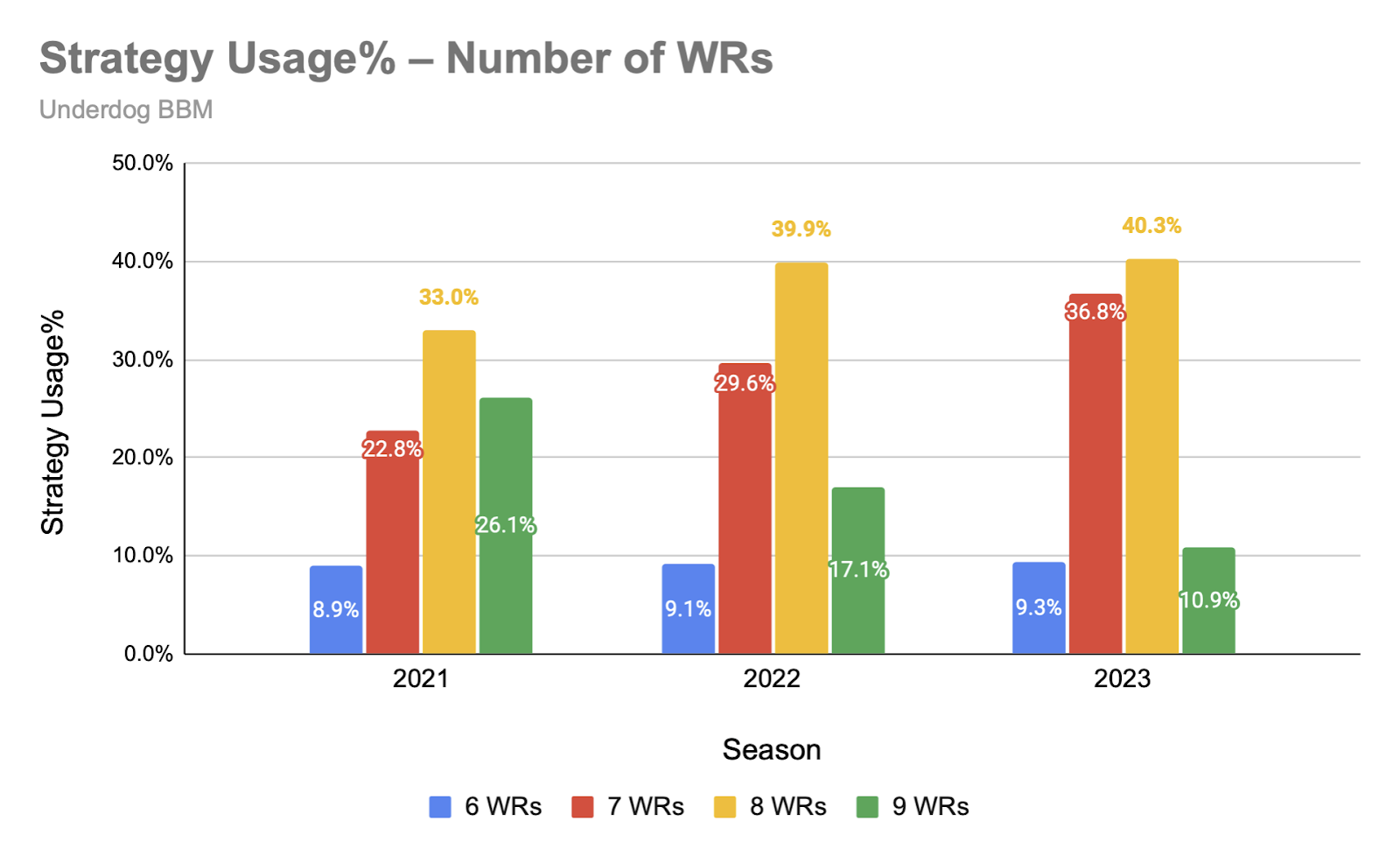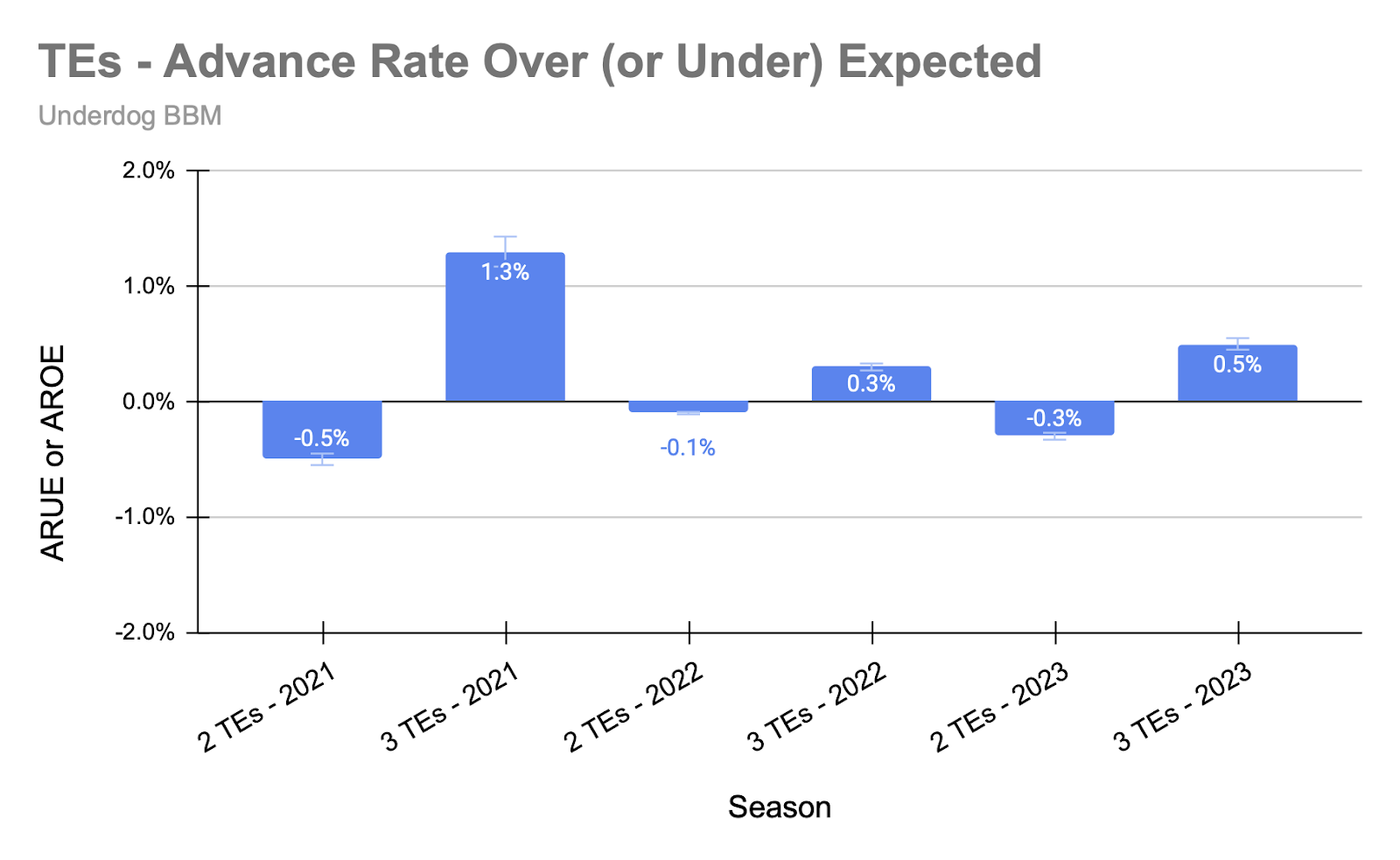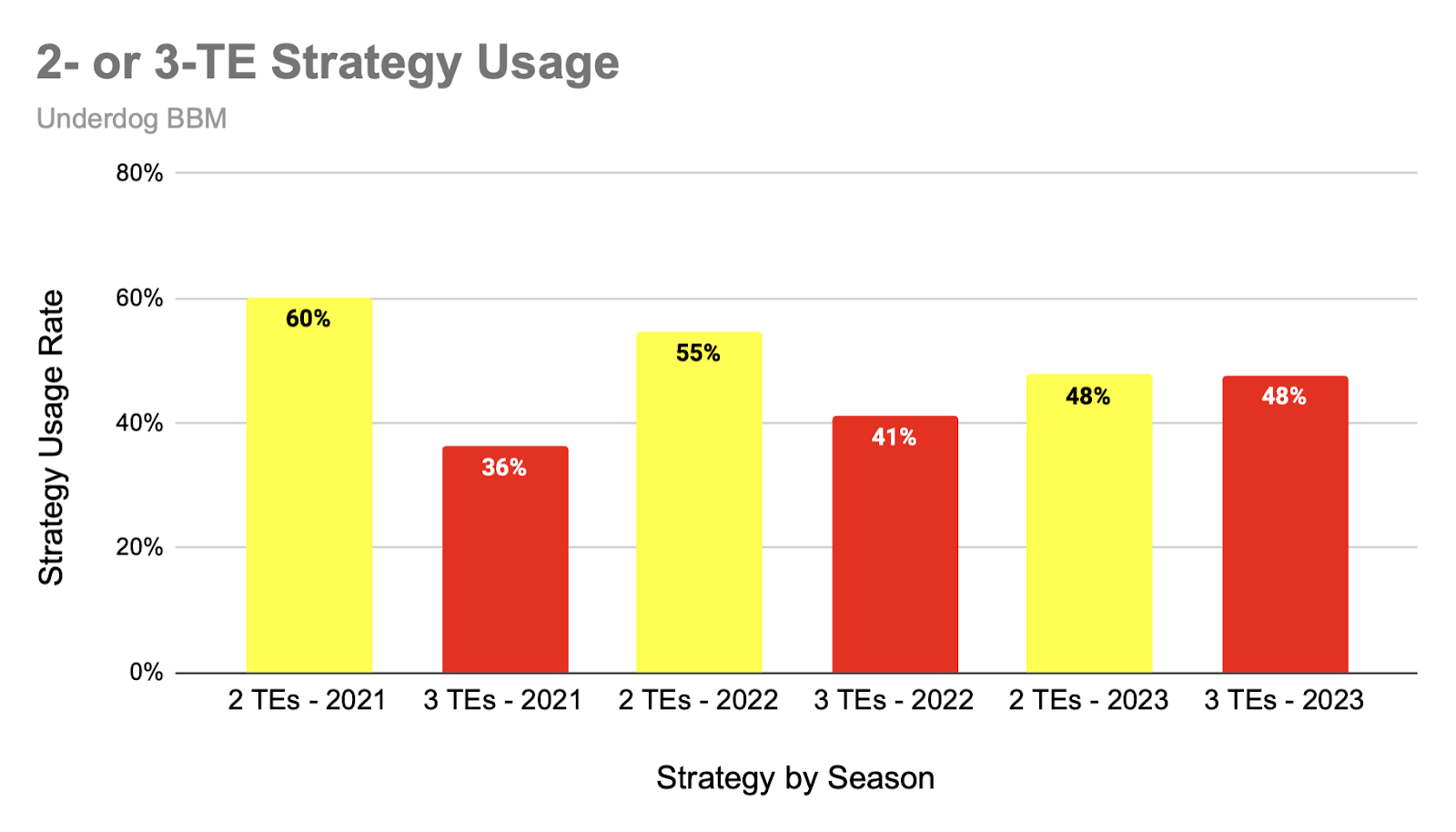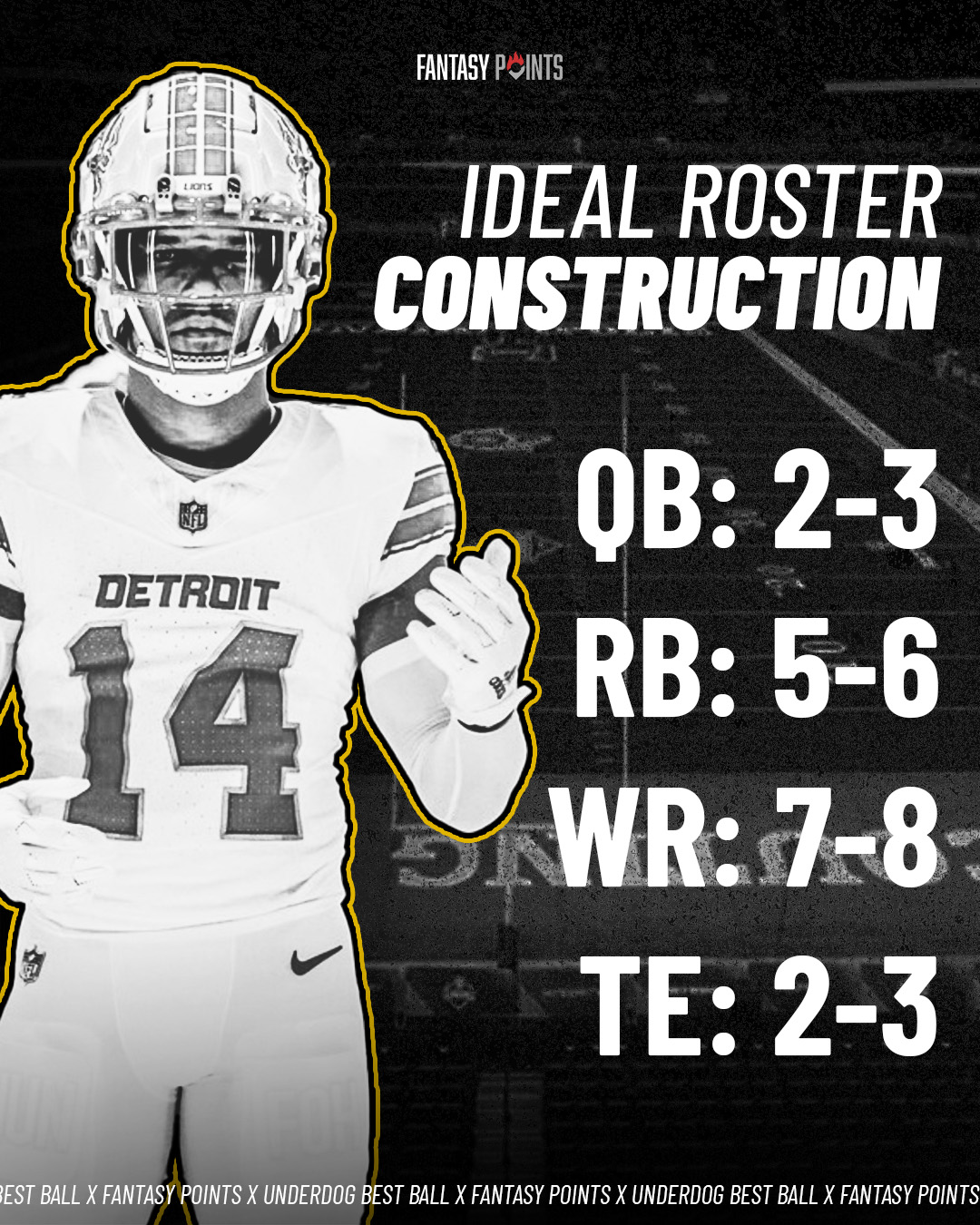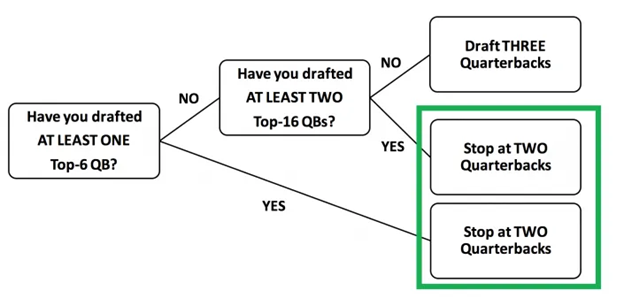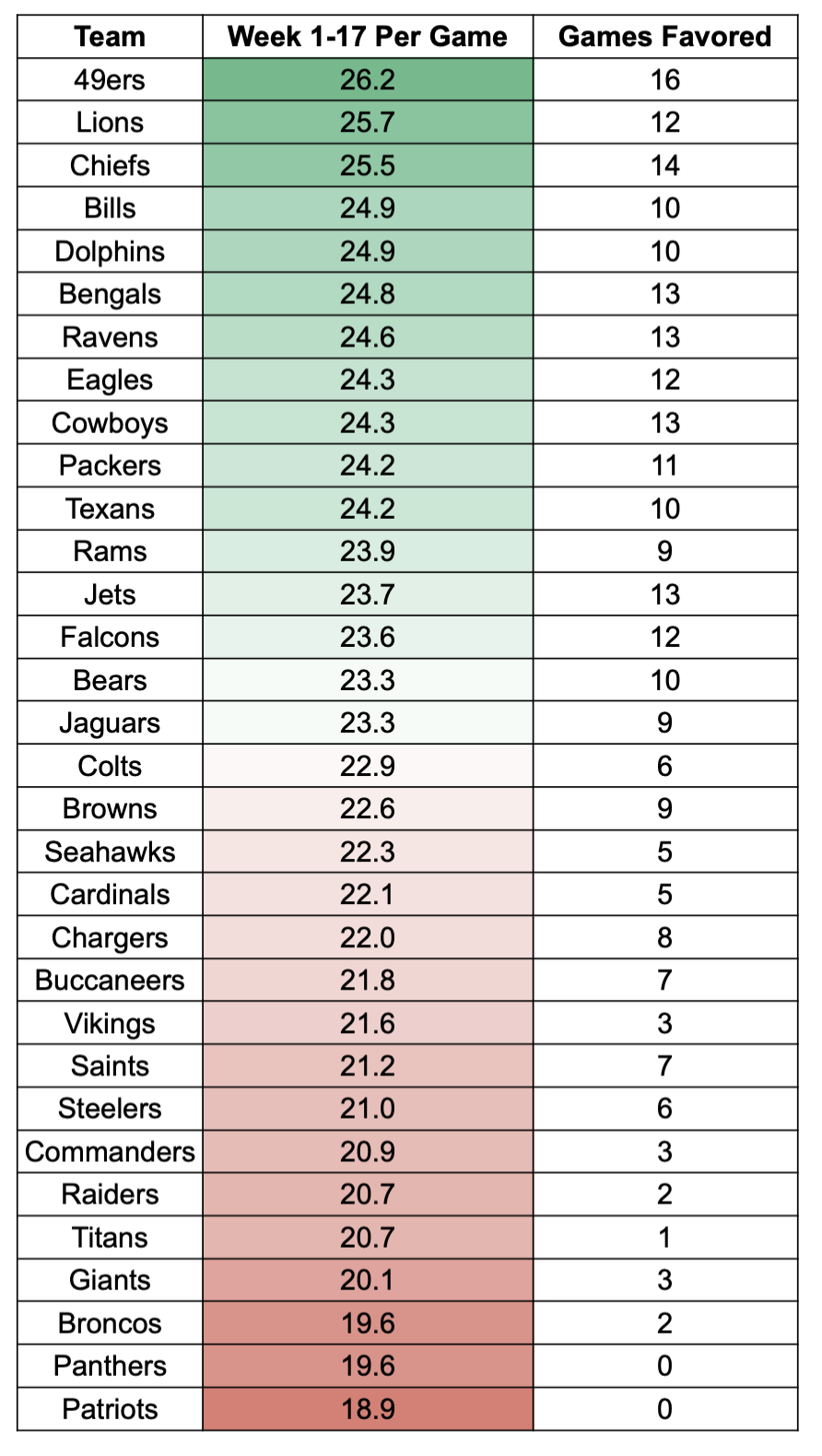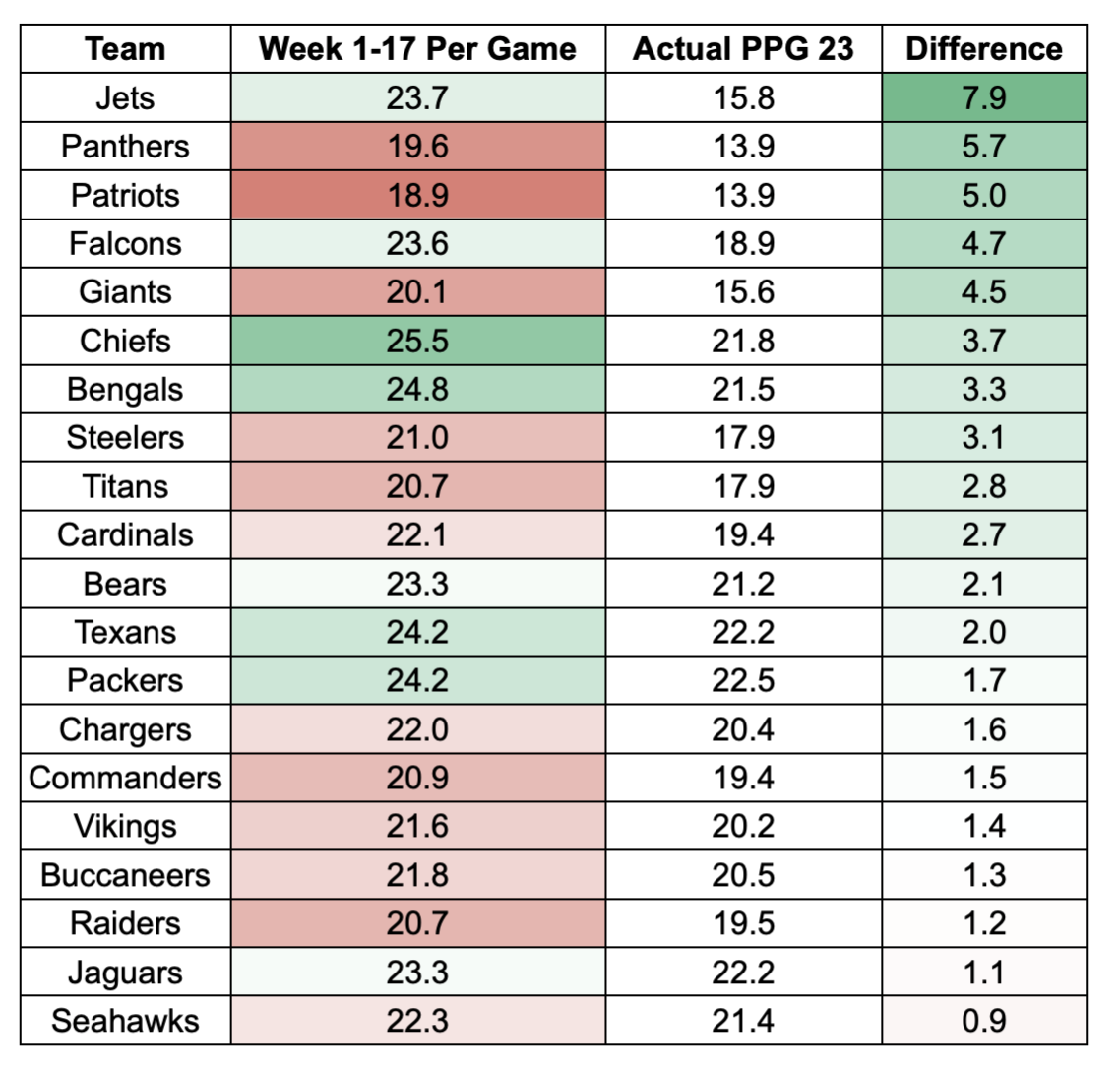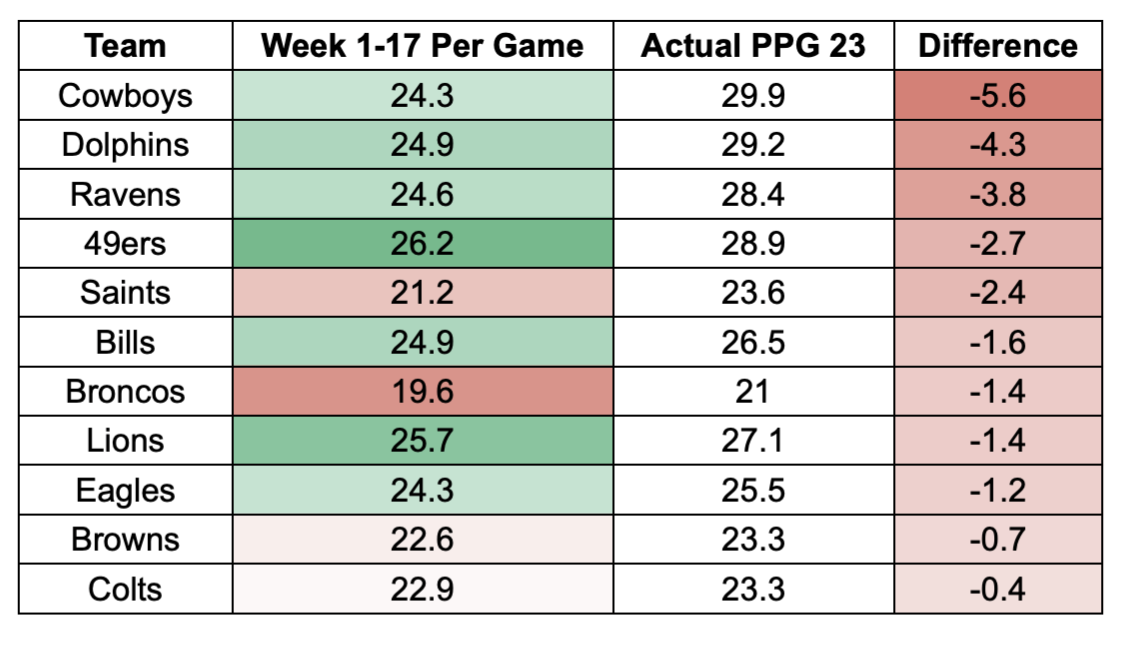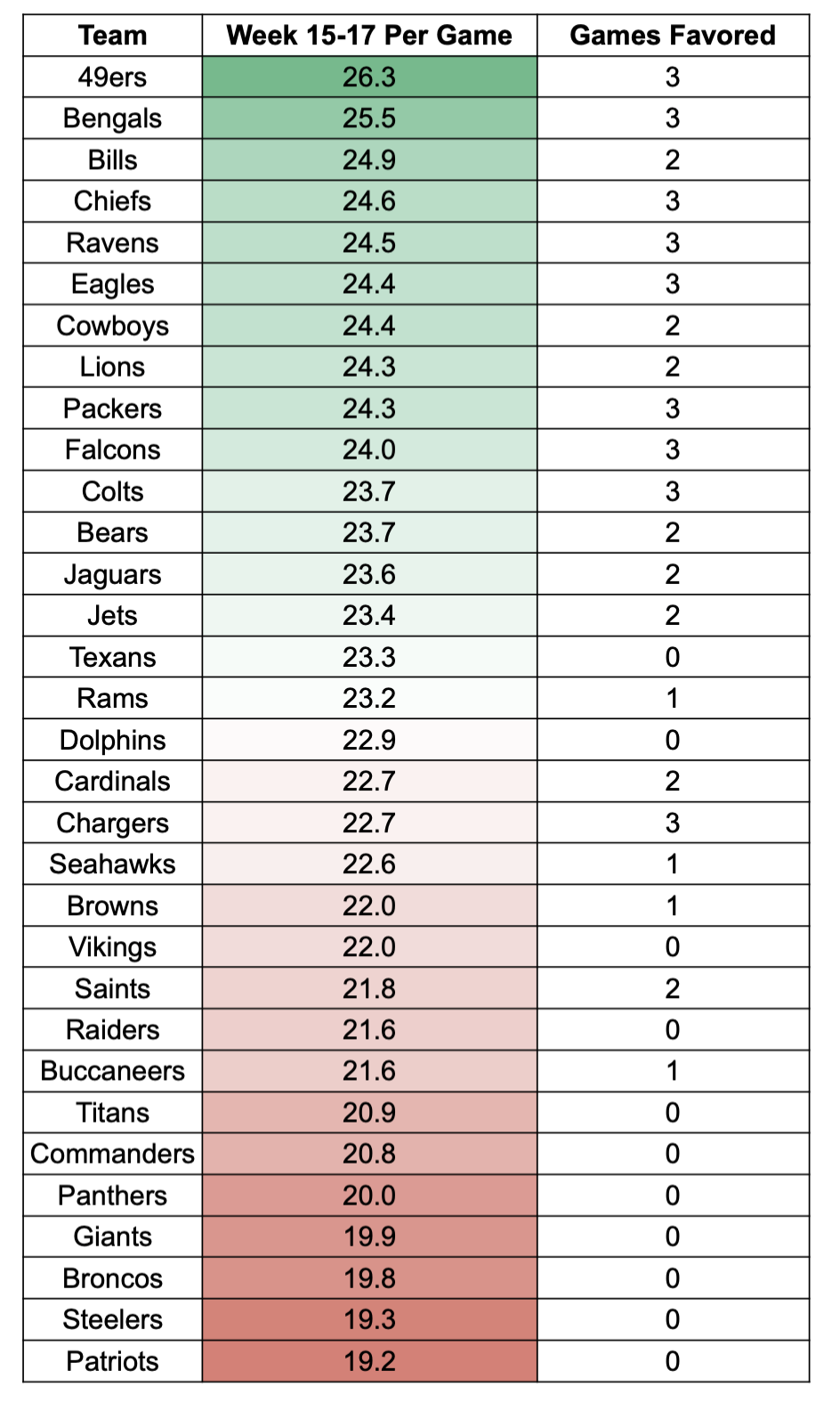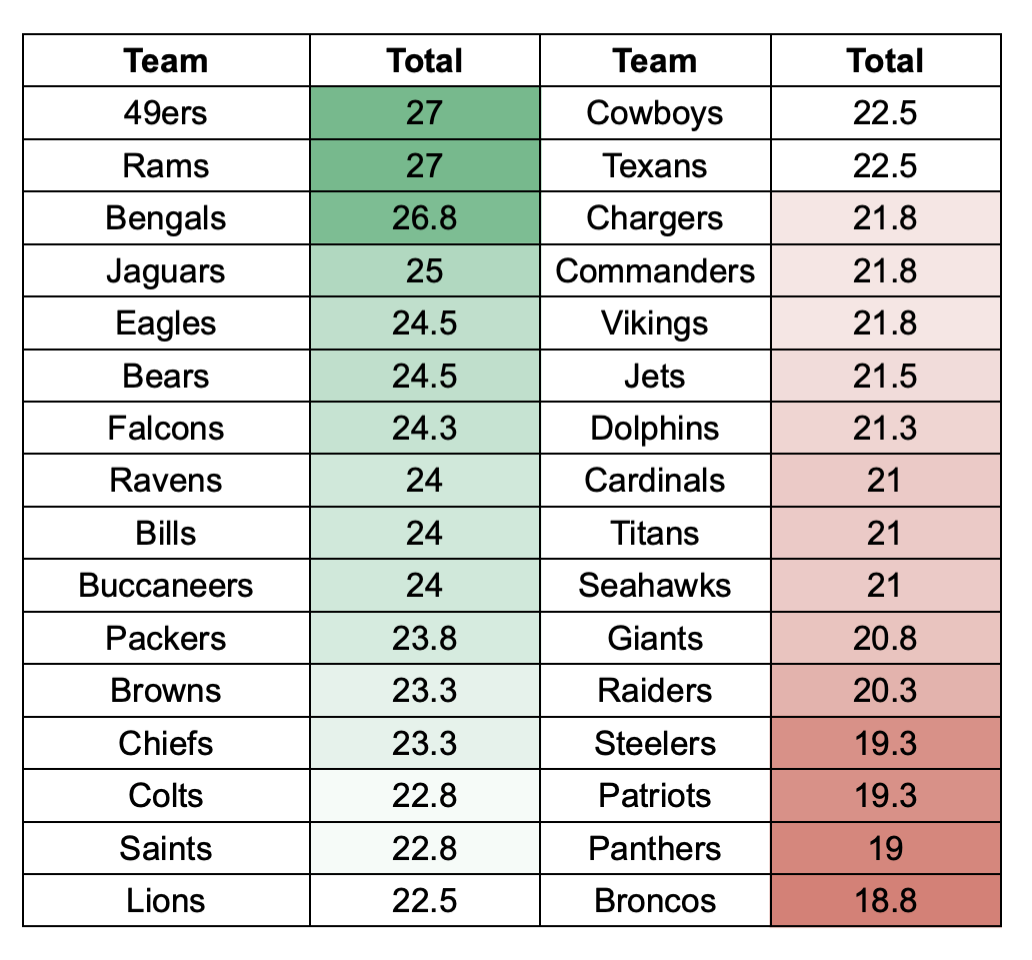Beating your friends, family, and co-workers in your fantasy football leagues is fun. Bragging rights for the year and a couple extra bucks in your pocket is always great.
Do you know what sounds even better, though? Winning $1.5M playing best ball fantasy football on Underdog Fantasy. Best ball is great for playing fantasy without in-season management or any time demands beyond drafting.
Think of these tournament-style best ball leagues in the same way you would a DFS tournament (GPP) – you’re either first or last. To even have a chance to win Underdog’s flagship Best Ball Mania 5, you have to advance as a top-2 scoring team in Weeks 1-14 and then win two consecutive uncorrelated weekly tournaments (in Weeks 15 and 16) just to make it to the finals.
Just for context, 0.0008% of the entrants into Best Ball Mania 5 will make the finals. Because the field is massive and the number of roster combinations we can face is virtually limitless, we must set some hard and fast rules for building our teams.
This isn’t dissimilar from a card game. Blackjack is a game of optionality with repeatable rules for each hand. Some rules are obvious – “Stand on 20” and “Split Aces.”
Blackjack is a conditional game with known downside if you repeatedly play the “wrong” way. Best ball isn’t too dissimilar.
In blackjack – If you hit one too many times, you bust and lose 100%.
In best ball – If you draft three early-round QBs, you bust and lose 100%.
In this article, we will be discussing all of the key trends, roster construction strategy tips, and conditional drafting rules that you will need to profit on Underdog.
Best Ball Mania 5
Underdog made some great changes to the way they’re paying out the final round (Week 17) that will make a difference this season. The payouts are much flatter overall and they’ve eliminated the top scoring prizes for the regular season. As a result, Underdog just infused the finals with more cash.
If you make the Week 17 finals, your minimum payout ($3,750) is equal to the cost of max-entering the tournament ($25 entry times 150 entries = $3,750).
Furthermore, if you finish 100th in the finals, you will earn $11,000. Last year, the 100th place finish in the finals was worth $5,000 – 55% less.
Round Advancement
Regular Season (Round 1): The top-2 highest-scoring teams in each league from the fantasy regular season in Weeks 1-14 will advance to the quarterfinals round (16.7% odds of advancing).
Quarterfinals (Round 2): For Week 15, the first and second-place finishers from every league are placed in 13-person groups. The top-scoring team from each group advances to the semifinals (7.6% odds of advancing once you’ve made it this far).
Semifinals (Round 3): Round 3 consists of 539 16-person groups, and the highest scorer from each group advances to the finals round (6.3% odds of advancing once you’ve made it this far).
Finals: The remaining 539 entries will all battle it out for the top prizes.
Payout Structure
Underdog Scoring and Roster Requirements
Underdog uses 0.5 PPR best ball scoring, and the roster requirements are above. Every draft is 18 rounds, and there is no in-season weekly management (waivers/trades).
We’ll dive deep into roster construction and how you should allocate your draft capital at each position in detail below. Let’s begin with an overview of how scoring works and how to think through filling the all-important FLEX spot.
Since we’re forced to start at least three receivers compared to two running backs, you will draft more WRs than RBs. It’s just the name of the game. This particular season is extremely WR-heavy early in drafts because only a handful of running backs are every-down bellcows on good offenses.
So, which position will you want filling your FLEX spot more often – runners or receivers?
Filling the FLEX
Last season, the average score for a replacement-level FLEX starter was 8.5 Half-PPR points. Of course, you will want much more upside than that on a weekly basis in your FLEX spot. This is just a look at how many fantasy points it takes to “fill” the FLEX with a replacement-level score.
Wide receivers make up exactly 50% of all instances of at least 8.5 Half-PPR points, with running backs (35.7%) lagging behind. Generally speaking, wide receivers are more likely to give you a replacement-level “floor” score than running backs.
Receiver scoring is a lot more talent-driven and binary than it is for runners. Wideouts are either earning targets and scoring FP on those looks or not. Running backs can get 15 touches (13 carries, 2 receptions) in a game and only churn out 55 scoreless yards from scrimmage (6.5 FP) because it takes more things that are out of their control for them to be successful, like run blocking and how often the offense gets into the red-zone.
Finding replacement-level players is easy. On average, there are 74 FLEX players (RB/WR/TE) who will score at least 8.5 FP in a given week.
But what about top scores? After all, we’re trying to win a tournament here. Let’s take a look at the positional averages for top-12 weekly scorers at RB and WR.
On a weekly basis, the RB6 averages 15.5 Half-PPR points per game, and the WR6 scores 15.1 FPG. Let’s run the same study as above. Which position is more likely to give you at least 15 FP to get near a top-12 positional score?
We see that running backs make up some ground on wide receivers when it comes to back-end top-12 weekly scorers – at least 15 FP weekly – but it’s still not enough. Wideouts still make up nearly half of the occurrences of at least 15 FP.
Nearly the same scoring distribution exists when we take a look at high scores. To measure this, we’re looking at all games that are at least 2.25 times above replacement level (8.5 FP).
Finally, here is a chart for all games of at least 19.5 FP:
No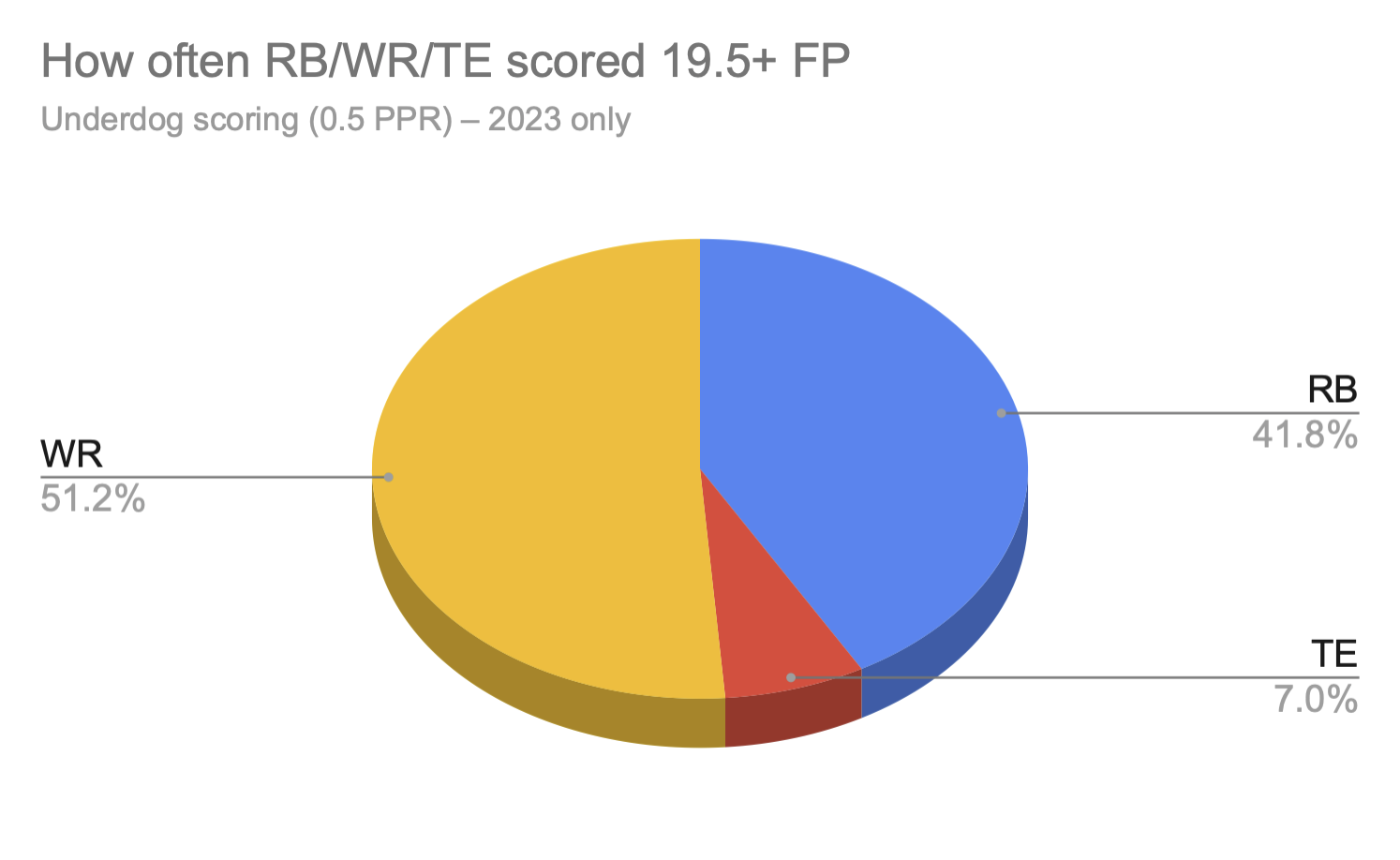
Speaking of which, TEs only make up 7% of all top-scoring games (19.5 or more FP). Tight ends should not be relied upon to produce FLEX-worthy weeks consistently. This is also an indictment against taking two tight ends early in best ball drafts simply because they do not come close to keeping pace with WRs and RBs that fill up “floor” and “ceiling” game occurrences. When you take two elite tight ends early, you’re forgoing a potential stud WR3 or RB1-2. Opportunity cost really matters in best ball.
ADP Trends
One thing is clear: fantasy drafters don’t love running backs this year. We’re seeing wide receivers take over, as the majority of Underdog entrants correctly prioritize their WR2 and WR3 spots over running backs. It’s a race to fill the FLEX.
However, it’s not just because the wide receiver pool is so deep and drafters are chasing them. We’re witnessing a slow death of the bellcow RBs. Christian McCaffrey, Bijan Robinson, and Breece Hall are the only three running backs with strong volume and high ceilings on good offenses to match the elite WR options in Round 1.
After that, every RB has warts – it’s just a matter of how many.
The second round of drafts is filled with talented RB1-type runners and legitimate questions around them. Jonathan Taylor is awesome, but he might not have a true league-winning ceiling because Anthony Richardson is the goal-line back. The same can be said of Saquon Barkley with Jalen Hurts in Philadelphia. Jahmyr Gibbs looks like a superstar, but David Montgomery will remain a thorn in his side (for fantasy) this season. I think De’Von Achane could break fantasy football leagues if he starts 14-15 games, but we also have to realize his downside risk in his profile due to his size and backfield competition from Raheem Mostert and rookie Jaylen Wright with a head coach in Mike McDaniel that loves committees.
With the NFL expanding the season to 17 games, we’re seeing way more teams employ a committee backfield approach to keep their runners healthy. It makes perfect logical sense if you’re a coach, but it’s certainly making fantasy football harder.
We saw 42 different running backs play at least 45% of their team’s snaps last season. Dating back to 2015, that was easily a new high. And it was 12.1% higher than the eight-year average (36.9 RBs).
Number of running backs who played at least 45% of team snaps
Since 2015
2015 – 33
2016 – 39
2017 – 34
2018 – 38
2019 – 37
2020 – 37
2021 – 37
2022 – 40
2023 – 42
With this shift in place, wide receivers are skyrocketing up draft boards in the 2nd-8th rounds at a pace we haven’t seen before. Take a look at this graph below that tracks WR average draft position (overall) for the 1st through 50th receiver selected over the last three seasons:
NOTE: This graph stops at WR50 in ADP.
Take a look at the yellow line labeled “2024 ADP.” The first round is receiver-heavy — like usual — but begins to detach from previous years around 25 overall.
There are 25 receivers drafted in the first 40 picks this season. Over the previous two years of Underdog drafts, the 25th receiver was taken at ADP 50.8 overall on average. The 2nd-8th round of drafts are far more receiver-heavy than ever, and that is naturally pushing running backs down the board further than in recent years.
Here is the same ADP graph for receivers over the last three years, but this time, we’re looking at WR51-100 in Rounds 9-18 of drafts. As you can see, the wideout market is closely in line with the three-year norms once we get into the double-digit rounds of drafts. These receivers are not being pushed up in the same way as the early-round options as drafters start shifting to RB depth in this range.
NOTE: This graph starts at WR51 in ADP.
So, receivers are being pushed up over running backs in the early rounds, but we can generally expect the WR60 to be selected at basically the same cost as the previous two years (132 overall). You will likely want to draft your WR3 earlier this year, but that doesn’t mean that you will have a hard time drafting your WR6-7 in the late rounds.
Finally, here is a look at the RB market over the last three years:
The “RB dead zone” in Rounds 4-7 doesn’t exist anymore. Back in 2022 on Underdog, we saw 20 running backs taken within the first 56 picks (overall ADP). This season? On average, the RB20 isn’t coming off the board until 78 overall.
Running backs are on sale – relative to historical pricing – all throughout the draft. This means that the Zero RB draft strategy is even more viable than usual this year because of the number of running backs coming off the board in Rounds 6-10.
On average, there are 24 RBs selected from 60-120 overall in drafts this season. Last year, there were 21 backs taken in the 60-120 ADP pocket. In 2022, just 19 RBs were selected from Round 6 until the end of Round 10. It was much more RB-heavy in the early rounds three years ago.
The weaker running back market makes building around an elite QB and/or TE in the early rounds easier than ever. Since we can draft RB2-type profiles with upside well into the 8th-10th rounds, it makes the early-round QB/TE options even more attractive since you’re not forgoing as much opportunity cost at running back. Unless you’re loading up on running backs early, most people are naturally filling their RB2, RB3, and RB4 slots significantly later in drafts this year.
Roster Construction and Positional Strategies
In this section, we’ll be discussing a few key ideas about which strategies give us the best chances of winning on Underdog. The first point of these studies is to test which roster construction strategies help and hurt your chances of advancing to the Week 15 playoffs. We have to get there first to have a chance to win in Week 17. The goal here is to study what works and then consistently draft structurally sound teams.
A thought experiment: If we gave every person in your 12-team draft the same skill level and ignored randomness, then everyone’s equal chances of advancing as a top-2 scoring team to the playoff round in Week 15 is 16.67% (two out of 12). Two teams advance out of 12 in every league.
To measure the particular advance rate for these positional strategies, we can do so by comparing your baseline “neutral” odds (16.67%) against the data for the varying roster construction strategies (i.e. 2-QB vs. 3-QB builds). By measuring advance rate over or under expected (AROE or ARUE) – where 16.7% is perfectly average – we will have a better grasp on the strategies that give us the biggest edge in building rosters within the confines of Underdog’s 18-round structure.
For example, 3-QB builds actually had a higher advance rate over expectation (0.5%) to the Week 15 playoffs last season than 2-QB teams (-0.2% under expectation). This was not the case for the prior two seasons when teams that selected just two QBs advanced at a 0.7% clip above expectation.
AROE = Advance Rate Over Expectation (to Week 15 playoffs)
ARUE = Advance Rate Under Expectation
We’ll take these ideas a step further in the following section on Conditional Drafting Rules.
NOTE: Shoutout to Underdog for releasing their Best Ball Mania data yearly. This is my third year compiling and crunching the data and second year publishing research. All of the data in the following two sections looks at roster construction solely through the lens of BBM. These ideas can be broadly applied to other contests – but be aware of the advancement structure by round and payouts in every tournament you enter.
Quarterbacks
Generally speaking, two QB roster builds are the most optimal by AROE – but not by much. Over the last three seasons of BBM, rosters with two QBs have an AROE of 0.2%.
Remember, 3-QB builds actually had a higher AROE (0.5%) last season than 2-QB teams (-0.2% ARUE). This was largely driven by Brock Purdy (156 ADP – QB22), CJ Stroud (207 ADP – QB30), and their frequently-stacked receivers blowing out their average draft position as massive values. It also “helped” those optimal 3-QB teams that Joe Burrow, Aaron Rodgers, Kirk Cousins, Anthony Richardson, and Deshaun Watson all missed large swaths of time.
Do not ever make the mistake of taking one elite QB and then loading up elsewhere. It just absolutely nukes your advance rate potential by -4.3% under expectation. Taking a zero during your QB’s bye and leaving yourself open to multiple zeroes if they get injured is way too much downside risk.
The same can be said of teams with four or more quarterbacks, which produce an ugly -3.2% ARUE. Stick to 2-3 QBs in all of your Underdog drafts.
Below are the last three years of AROE data. We’re solely looking at rosters with exactly two or three quarterbacks.
And here is how often the 2- or 3-QB strategy has been used over the last three years in BBM.
In aggregate, 96.1% of all teams drafted in BBM over the last three seasons have drafted two or three quarterbacks. On average, 57.3% of teams drafted two passers, while 38.8% took three QBs. In the section below, we’ll discuss when it’s most appropriate to take three quarterbacks.
Running Backs
Over the last three years, drafting exactly five or six running backs has been optimal in every single BBM tournament. Crucially, this analysis ignores when these runners were drafted and all other positions. There are a few limited scenarios where drafting only four or up to seven running backs makes sense.
Here is the advance rate data for each bin – 4, 5, 6, or 7 RBs drafted:
| Number of RBs | 2021 | 2022 | 2023 |
| 4 | -1.1% ARUE | -1.8% ARUE | -2.2% ARUE |
| 5 | 0.3% AROE | 0.1% AROE | 0.1% AROE |
| 6 | 0.3% AROE | 0.8% AROE | 0.5% AROE |
| 7 | -0.4% ARUE | -0.7 ARUE% | -0.1% ARUE |
The field mostly understands how many running backs you need to have. Hyper-fragile four running back teams have declined as a strategy for three straight seasons while more drafters are leaning on six RBs more often.
Last year, 83% of the entrants into BBM4 drafted exactly five or six running backs. However, when you draft those RBs matters a great deal. We’ll discuss this topic at length in the following section.
Wide Receivers
In the last three BBM tournaments, drafting exactly seven wide receivers is the only strategy that has posted a positive advance rate over expectation in every season:
| Number of WRs | 2021 | 2022 | 2023 |
| 6 | 0.6% AROE | -1.1% ARUE | -0.2% ARUE |
| 7 | 0.3% AROE | 0.3% AROE | 1.1% AROE |
| 8 | 0.3% AROE | 0.6% AROE | -0.1% ARUE |
| 9 | -0.2% AROE | -0.5% ARUE | -2.2% ARUE |
Underdog teams with exactly eight receivers have performed slightly above expectation in aggregate over the last three seasons (0.3% AROE) despite the mediocre results in 2023 comparatively.
The rate at which drafters take exactly 7 WRs has gone up every single year of BBM:
On the flipside, the field drafted nine wideouts significantly less often last season (10.9%) than two years ago (26.1%) or in the 2022 tournament (17.1%). Wide receivers are less likely to “bust” and give you nothing but zeroes in the late rounds compared to running backs, but if you’re taking as many as nine in total, it’s likely because you didn’t prioritize them early enough in your draft.
Tight Ends
In each of the last three BBM tournaments, drafting three tight ends has performed better than teams with just two TEs in advancing to the Week 15 playoffs:
You’re likely wondering how rosters with three tight ends are slightly more optimal than just 2 since these players rarely have enough upside to fill the FLEX. Well, the extra depth really helps smooth out TD luck. Tight ends live and die by touchdowns.
To show this, here is a look at how total touchdowns scored correlate to positional fantasy points over the last two years:
| Position | TD-to-FP RSQ |
| QB | 0.931 |
| RB | 0.734 |
| WR | 0.661 |
| TE | 0.571 |
The right value is the r-squared (RSQ) relationship between total touchdowns scored (rushing, passing, and receiving) and total fantasy points scored. RSQ measures the consistency and correlation for a dependent variable – in this instance, fantasy points – that’s explained by an independent variable (touchdowns).
For context, this means that 93.1% of the scoring variance for quarterbacks is explained by touchdowns alone. That figure for tight ends is just 57.1%.
You might say, then… “Wait a minute. You just told me tight ends live and die by touchdowns. But tight end touchdowns also have the lowest correlation to actual fantasy production?”
Yes! It’s well established that touchdowns are just easier to predict at QB or RB as opposed to TE — quality of offensive line, supporting cast, etc. translate better to predictability at those positions.
In turn, this makes the tight ends who actually get into the endzone with some semblance of consistency more valuable in fantasy football. And if you don’t get one of those unicorns, you are better off taking three tight ends in best ball.
Over the last five years, there have only been 15 occurrences where a tight end scored more than 8 TDs in a single season. Only one TE met that mark last year – Sam LaPorta.
Dating back to 2010, just 12 tight ends have scored more than 8 TDs in multiple seasons. Here’s the list:
| Player | Count | From | To |
| Jimmy Graham | 6 | 2011 | 2020 |
| Rob Gronkowski | 6 | 2010 | 2017 |
| Travis Kelce | 5 | 2017 | 2022 |
| Mark Andrews | 2 | 2019 | 2021 |
| Zach Ertz | 2 | 2017 | 2018 |
| Hunter Henry | 2 | 2016 | 2021 |
| Julius Thomas | 2 | 2013 | 2014 |
| Tony Gonzalez | 2 | 2012 | 2013 |
| Kyle Rudolph | 2 | 2012 | 2017 |
| Antonio Gates | 2 | 2010 | 2014 |
| Jason Witten | 2 | 2010 | 2013 |
By comparison, 50 wide receivers have scored at least 8 TDs in a single-season multiple times since 2010. Since touchdowns are more random at tight end than all other positions, we need to have the quality vs. quantity discussion for best ball. The field is following the success of 3-TE rosters. For the first time in Best Ball Mania history, 3-TE builds were just as popular as 2-TE teams last season.
We saw three late-round tight ends with an ADP of 125 overall or later absolutely blow away their cost in last season’s drafts. Sam LaPorta (ADP: TE13 | Finish: TE3), Jake Ferguson (ADP: TE19 | Finish: TE9), and Trey McBride (ADP: TE33 | Finish: TE10) all carried best ball teams down the stretch run. LaPorta and Ferguson were among the top 20 individual players in advance rate in particular.
The overwhelming majority of tight ends that provide the most leverage during the regular season are drafted in the late rounds. Over the last three years, 20 of the top-26 TEs by regular season advance rate were drafted at 135 overall or later. That’s 77%.
Yes, drafting three tight ends is slightly more optimal in a vacuum. It’s best to remember that all of this data is descriptive in nature. For example, it’s likely that the teams that were taking Trey McBride in the last round last season had 2 TEs already rostered. Your first two tight ends could have been absolute duds, and McBride would have carried you throughout the playoff weeks.
Taking two tight ends – George Kittle in Round 6 and then LaPorta in Round 12-13 – would have been “perfectly optimal” last regular season. The good news is that we don’t always have to be perfect at tight end because of the randomness of TDs. The BBMIV winner drafted three tight ends, but it’s clear that LaPorta carried the roster throughout the plurality of the season. Pat Freiermuth was the TE1, and Juwan Johnson was the TE3.
Ideal Roster Construction
Conditional Drafting Rules
Alright, we have set rules on how to allocate positions in our best ball leagues. Roster construction is just the framework for drafts. What’s equally important is drafting the right number of positions in the right rounds. Best ball is a game of near-infinite optionality inside a market, so we have to start paying special attention to positional allocation and planning out stacks.
In this section, we will take roster constriction a step further and discuss the most optimal conditional drafting strategies to crush your drafts. All of this information is descriptive and looks at roster construction from a historical lens, so be mindful that every strategy might not be predictive for this year. Every season is a different puzzle with a new 10,000-piece set to try to figure out. The goal is to be directionally accurate and heavily focused on opportunity cost.
Conditional Drafting – Quarterbacks
Generally speaking, the likelihood that you select three QBs should decrease significantly the earlier you take your QB1. This is where the conditional aspect kicks in. After running backs, the markets are second-best at predicting quarterback performance (by historical correlation to ADP). Josh Allen scores 20 or more FP with regularity, while Bryce Young does not. Teams with Allen shouldn’t need a third QB because of the weekly floor/ceiling he provides.
Let’s look at the data.
If you take an elite QB1 in Rounds 1-5, stopping at two QBs is most optimal. Teams with an elite QB1 in Rounds 1-5 and a QB2 taken any time after Round 10 have produced a stellar AROE of 2.7% over the last three BBM. Drafting a third QB in this scenario hurts your advance rate odds by -1.3%. You’re better off using that roster spot on another position.
Inversely, it’s best to take three quarterbacks if you don’t have any rostered after Rounds 1-9. If you build a 3-QB team in Rounds 10-18, your AROE is 1.9%. If you stop at just two QBs in this scenario, you’re hurting your odds of advancing by -1.1%.
The advance rate data is really ugly if you push your late-round QB build deep into the draft and stop at just two passers.
If you take only two QBs in Rounds 12-18 – with zero rostered before then – your advance rate chances dip -1.9%. If you push it even further and only take two QBs in Rounds 13-18, your ARUE is -2.7%.
You should almost always take three QBs if you’re going with a late-round build. In theory, you should have plenty of quality and quantity at wide receiver if you went your first nine rounds without a quarterback.
The advance rate data is stellar for teams that draft at least five wide receivers in Rounds 1-9 and then take three quarterbacks in Rounds 10-18. Those best ball squads produce a strong 2.3% AROE.
So, if it looks like your draft is shaping up for 3 late-round quarterbacks, your ideal first nine rounds of roster construction is 5 WRs, 1 elite TE, and 3 RBs. All starting RB/WR/TE/FLEX slots are filled and you’d have two additional FLEX options on your bench already.
Here’s your QB decision tree (H/T Mike Beers):
This year, we have a particularly deep group at quarterback with the influx of cheap rookie passers and second-year QBs all with lowly ADPs. Maybe we don’t see two quarterbacks carry best ball teams to the degree at which Purdy and Stroud did last season, but we can draft potentially ascending starters that we know will start all 16 games – like Will Levis – at 180 overall ADP this year. Drake Maye, Justin Fields, and Daniel Jones all have standalone rushing upside, and they’re going 190 overall or later. They’re basically free.
On teams where I don’t take an elite QB early, I’m much more willing to take a QB3 this year than filling multiple RB/WR spots in the last few rounds. There are so many teams that have yet to battle out their backup RB2 and RB3 spots, and that’s left the late-round runners bone dry. These market dynamics should push you towards a third QB late – especially if you hammer wide receivers in the early rounds don’t spend any premium draft capital at QB.
Conditional Drafting – Running Backs
This season’s ADP market is vastly different from prior years, fundamentally changing the drafting dynamics for mid-round runners. Remember, the RB20 isn’t coming off of the board until 78 overall. That’s 17.3 spots below the average from the previous two years.
Your first few picks should heavily dictate your ending roster construction and how you allocate draft capital at all four positions. Every pick you make should give you information on the proceeding selection, and draft capital is obviously never more important than in the early rounds. It’s easy to tank your draft early by not prioritizing receivers, and that’s especially the case this season because of the depth of runners being selected past 75 overall.
The following table is a look at the most popular draft start types in the first 3 rounds and their advance rates (to the Week 15 playoffs) in Best Ball Mania. This data does not include the drafts of a TE1 in Rounds 1-2 since those were basically all Travis Kelce teams. This year, Sam LaPorta is the first TE off of the board, around 29-30 overall. We’re also ignoring all teams with a QB1 drafted in Rounds 1-2. Top QBs Josh Allen and Jalen Hurts are not drafted until the 3rd round at the earliest this year.
This data is sorted by how often the strategy is used from most to least popular:
| Start type (R1-R2-R3) | Advance Rate O/U% | Strategy Usage% |
| RB-RB-WR | -2.8% ARUE | 11.1% |
| RB-WR-WR | -1.6% ARUE | 9.8% |
| WR-RB-WR | -0.3% ARUE | 9.3% |
| WR-WR-WR | 2.5% AROE | 9.2% |
| WR-WR-RB | 1.9 AROE% | 8.1% |
| RB-WR-RB | -2.5% ARUE | 5.4% |
| WR-WR-QB | 4.3% AROE | 4.1% |
| WR-RB-QB | 5.4% AROE | 3.5% |
| RB-RB-RB | -3.9% ARUE | 3.5% |
| RB-WR-QB | 5.9% AROE | 2.5% |
| RB-WR-TE | -3.6% ARUE | 2.0% |
| RB-RB-QB | 4.3% AROE | 1.9% |
| WR-WR-TE | -1.4% ARUE | 1.9% |
| WR-RB-TE | -3% ARUE | 1.6% |
Out of the five most popular start types, the two with the worst historical advance rates are teams that went RB-RB-WR (-2.8% ARUE) or RB-WR-WR (-1.6% ARUE) in Rounds 1-3. Meanwhile, teams that started their draft with three straight wide receivers (2.5% AROE) or WR-WR-RB (1.9% AROE) have fared much better.
If you start your draft WR-WR, teams that take six running backs over the remainder of the draft have a higher AROE (3%) than teams that stop at 5 RBs (1.9% AROE). With 17 WRs and 8 RBs going in the top 24, we’ll see a relatively higher amount of WR-WR starts this season than in prior years.
This doesn’t mean that drafting two RBs in the first 3 rounds is a “bad” strategy in every league, but this does clearly highlight the value of prioritizing receivers early. If we ignore ending roster construction and solely look at the opening three picks, then it’s even more clear. Teams that took at least two WRs in Rounds 1-3 have posted a modest 1.1% AROE in BBM. Meanwhile, the best ball rosters with at least two RBs in Rounds 1-3 have returned a significantly lower -1.9% ARUE.
If you do hammer running backs early – with two in the first three rounds – you need to be extremely aware of how many you take for the rest of the draft. It’s time to load up on WRs.
If you begin your draft with two RBs in the first three rounds, you’re basically locked into stopping at 5 runners total. Teams that take two running backs in the first three rounds and end with at least 6 RBs total have posted a miserable -3.7% ARUE.
Best ball teams with just 4 RBs rostered can be a cheat code because you flip the fragility of runners upside down by taking 3-4 early-round options and then take a quantity > quality approach at WR in the late rounds. The logic is simple. If you’re drafting RBs early and they get hurt, you’re screwed anyway. If those early-round RBs pay off ADP and provide the massive weekly ceiling that you expect, you’re not going to need much depth at RB3-4.
For example, if you take Christian McCaffrey at #1 overall, a receiver at #24, and then De’Von Achane at #25 – you’re loaded with the best ceiling outcome possible at RB. The advance rate data is slightly favorable for stopping at 4 RBs rostered in this scenario.
Teams that start drafts RB-RB in Rounds 1-2 and then stopped at four running backs rostered have marginally outperformed teams by advance rate over expectation (by 0.1%). However, just 19.4% of drafters that start RB-RB actually stop at four running backs.
There’s massive downside risk in not prioritizing enough receivers early, though. We’ll work through those ideas in the next section on wideouts.
Building around just one Hero RB in the early rounds and then hammering other positions continues to be the premier strategy if you’re sold on one of the top runners, though. In this scenario, you take just one RB in Rounds 1-3 and then do not take your RB2 until Round 7 at the earliest. The Hero RB strategy has performed above expectation for three straight seasons at 2.5% AROE overall.
Finally, let’s say that you avoid runners altogether in the early rounds and build a Zero-RB team. Is it better to go with more quantity at running back? For this study, we’ll classify Zero-RB starts as any team that began their draft WR-WR and have zero RBs through five rounds.
Zero-RB teams that wait until Round 6 or later to select their RB1 and draft at least six running backs have posted a very strong 3.2% AROE. On the flipside, teams that stopped at five RBs in this scenario have posted a significantly lower 1.5% AROE.
If you start your draft with a traditional Zero-RB construction – you should likely draft at least six running backs or maybe stretch to 7 RBs. This also depends on the strength of your receivers.
With a 3.5% AROE to the Week 15 playoffs, the teams that drafted seven running backs slightly outperformed the best ball rosters that stop at 6 RBs (3.2% AROE) after a traditional zero-RB start.
Conditional Drafting – Wide Receivers
Last season, a shade over 77% of entrants into Best Ball Mania drafted 7 or 8 WRs and no more. This doesn’t mean that every single team that you draft needs to be within this framework, but this is a directionally accurate guideline. When you select your receivers is the most important factor to be aware of when drafting.
The goal in this section is to zoom out. Let’s set some rules for receivers since we need to draft at least 7-8, and we’re racing to fill the FLEX.
Simply not having enough receivers rostered by the mid-rounds can tank your team's chances of making the Week 15 playoff round. Drafting at least four wide receivers in the first 7 rounds is most optimal.
| Strategy Type | Advance Rate O/U% | Strategy Usage% |
| 4 WRs Drafted in Rounds 1-7 | 1.3% AROE | 46.9% |
| 3 WRs Drafted in Rounds 1-7 | -0.7% ARUE | 38.4% |
| 2 WRs Drafted in Rounds 1-7 | -1.6% ARUE | 4.7% |
This is the most important conditional drafting fact to remember. Selecting 4 receivers in Rounds 1-7 should be your goal in every draft. Fill the FLEX with receivers early.
The data is very clear: If you have 4 WRs rostered between Rounds 1-7, it’s optimal to stop at seven wideouts total. The teams that take 4 WRs in the first seven rounds and stop at 7 WRs have earned a gigantic 2.6% AROE.
Taking eight total receivers in this scenario yields a significantly lower 1.2% AROE.
However, the plurality of drafters (42.4%) take eight receivers total after selecting 4 WRs in Rounds 1-7. This compares to 34.1% who stop at 7 WRs. From an opportunity cost standpoint, this is an edge. You should often stop at 7 total WRs drafted as opposed to 8 if you spend the first seven rounds hammering pass-catchers.
It’s not that you can’t win if you prioritize RB early. It just makes your path so much harder because you will be trying to make up ground on the rest of your league with shakier mid-round receivers. Taking your WR1 in Round 3 has yielded an ugly -2.8% ARUE.
If you begin your draft RB-RB-WR in Rounds 1-3, then you should draft nine wide receivers total. Best ball rosters with nine receivers rostered after a RB-RB-WR start have outperformed teams that stop at 8 WRs by a significant 1.2% margin in advance rate to the Week 15 playoffs.
However, only 18.9% of BBM entrants actually take nine receivers in this scenario. The field overwhelmingly makes the mistake of stopping at 7-8 WRs. Adding receiver depth really matters after prioritizing RB early.
Let’s cast a wide net and take an even deeper look at Rounds 1-9 under the microscope of wide receiver strategy:
| Strategy Type | Advance Rate O/U% | Strategy Usage% |
| 7 WRs Drafted in Rounds 1-9 | -1.5% AROE | 0.9% |
| 6 WRs Drafted in Rounds 1-9 | 0.3% AROE | 8.5% |
| 5 WRs Drafted in Rounds 1-9 | 0.6% AROE | 29.0% |
| 4 WRs Drafted in Rounds 1-9 | 0.1% AROE | 40.9% |
| 3 WRs Drafted in Rounds 1-9 | -0.8% AROE | 17.6% |
| 2 WRs Drafted in Rounds 1-9 | -2.9% AROE | 2.6% |
It’s clear right off of the bat that having between 4-6 WRs on your roster after Rounds 1-9 is most optimal. Taking at least 4 wideouts before Round 10 is the bare minimum rule.
Opportunity cost really matters. If you draft exactly five wide receivers in Rounds 1-9, it’s optimal to stop at 7 WRs total (2.8% AROE) as opposed to drafting 8 WRs (0.4% AROE). Clearly, there are diminishing returns by selecting too many receivers if you’ve already loaded up on quality and quantity in the early rounds.
This data further solidifies my thesis for this season. You’re better off spending your Round 17-18 darts on a QB3 instead of a WR8-9 if you don’t take an elite QB1 early and have at least 4-5 wide receivers rostered between Rounds 1-9.
Conditional Drafting – Tight Ends
We know that it’s most optimal to take three tight ends in total and the field is now building 2- and 3-TE rosters in equal proportions.
So, when is it right to stop at just two tight ends?
If you draft an elite TE1 in Rounds 1-4, it’s best to stop at 2 TEs total by a small margin. Over the last three years, teams with an elite TE1 that stopped at 2 TEs rostered had a slightly higher advance rate (by 0.8%) than teams that took 3 TEs total.
This year, 9-10 TEs are going off the board by the end of Round 9. If you miss out on all of them, you should heavily lean towards a 3-TE roster. Teams that finish with three tight ends rostered – after taking zero in Rounds 1-9 – have a 2.1% edge in advance rate over expectation than teams that stop at just two TEs in this scenario.
As you will remember, 2023 was an apocalyptically bad year for early-round tight ends. It’s unlikely that we see the position “bust” as hard as it did. Travis Kelce was still the TE1 last year, but he went from 15.4 FPG in 2022 down to 11.7 FPG. Mark Andrews was scoring right in line with his career norms, but he suffered a season-ending ankle injury in Week 11. Fifth-round pick Darren Waller dealt with injuries (again) and ended up being one of the worst top-60 picks you could have made.
Really, just three tight ends have dominated scoring throughout 2021-23 – Kelce, Andrews, and George Kittle.
In 2021, Mark Andrews (ADP 59 overall that year) was the “Power Law” tight end you needed during the fantasy playoffs, as he absolutely dominated when it mattered most with a ridiculous 29/376/4 in three games during Weeks 14-16.
That season, a whopping 65.6% of the teams that made the BBM2 finals had Andrews. Travis Kelce was on 12.5% of finals teams comparatively.
In 2022, Kelce absolutely dominated the regular season. During Weeks 1-14, Kelce scored a ridiculous 57% more fantasy points per game than TE2 Mark Andrews. Unsurprisingly, teams with Kelce crushed everyone.
If you drafted Kelce in the late-first or early-second rounds of 2022, you had a 30.4% likelihood of winning your league – which was a distance away from the TE2 in regular season win share, Evan Engram (24.7%).
Things changed in the fantasy playoffs, though.
During Weeks 15-17, Kelce scored zero TDs after scoring 12 times in his previous 13 games. He still had games of 10/105 receiving and 6/113 in Weeks 15-16, but his Week 17 dud was a killer.
While Kelce slowed down, George Kittle (ADP 51 overall in 2022) ran hotter than the sun as Deebo Samuel suffered multiple injuries that kept him off the field. Without Deebo in Weeks 15-17, Kittle was the focal point of the 49ers' offense. He scored 5 TDs in just 3 games.
Anyone who had Kittle in 2022 knows that he was a bust during the regular season. He was the TE8 by fantasy points per game (8.5) in Weeks 1-14, which culminated in a -1.4% regular-season win share below expected. Kittle was largely a drag on your roster all season until Deebo got hurt.
As a result of his hot run, Kittle ended up on 40% of finals teams and was on Pat Kerrane’s winning BBM3 roster two years ago. Kelce was on just 10% of finals teams comparatively.
This brings us full circle to last season. The scoring at tight end in Week 17 was an actual nightmare, further highlighting the weekly variance that we see at the position.
With millions of dollars on the line, these were your top-scoring TEs in the final week of the playoffs in 2023 in order: Juwan Johnson (scored TD), Isaiah Likely (2 TDs), David Njoku (didn’t score), Dallas Goedert (scored TD), Sam LaPorta (didn’t score), Johnny Mundt (scored TD), Dalton Kincaid (didn’t score), Taysom Hill (scored TD), and Evan Engram (didn’t score).
Tight ends live and die by touchdowns.
Stacking Rules
Understanding the optimal avenues for roster construction is only one piece of the puzzle in building solid best ball rosters. We don't settle for just solid, though. We want first place. The premier way to create additional upside on our best ball rosters is through stacking.
The total number of stacked players from the same team on your best ball roster – regardless of position – has a fairly positive relationship with the amount of regular season points your team scored. In fact, 24.7% of regular season fantasy scoring variance (measured by RSQ) is explained by the number of stacked players rostered.
So, your stacks alone will explain about a quarter of your team’s total season fantasy points scored. Since there is a positive relationship between the number of stacked players and points scored – we need to stack a lot of players to create variance (upside!) on our rosters.
The most obvious (and most popular) stack in best ball is QB1-WR1 – like Dak Prescott and CeeDee Lamb or Joe Burrow and Ja’Marr Chase.
Over the last three years of Best Ball Mania, any roster with a QB1-WR1 team stack has posted a 4.7% advance rate over expectation to the Week 15 playoffs. Crucially, this data ignores when you drafted these players or the NFL team itself. We’re only looking at best ball rosters with a quarterback stacked with his top wide receiver (by targets).
Of course, you have to identify the top-scoring stacks in the first place. We want to build structurally sound rosters and have at least one team stack to supercharge our weekly range of outcomes.
Let’s take this a step further and examine the stack constructions that generate the most leverage in the regular season.
Among the top-12 most common team stacks that had the QB rostered, the three with the highest advance rate over expectation are easily QB + RB + WR1 or WR2 combinations. Best ball rosters with the QB, one RB, and at least the WR1 or WR2 from the same team have produced a monstrous 8.5% AROE.
This is followed by QB-WR-TE team stacks (4.6% AROE) and QB-WR1-WR2 stacks (2.6% AROE).
Of course, the classic chicken vs. egg argument is to be made here. Are these higher scoring teams with top-scoring stacks performing above expectation because of the team stacks themselves or because the drafter is taking the right positions in the right rounds, which turns out to be a great stack?
Best ball is the ultimate game of optionality – up until a point. Stacking minimizes the things you have to “get right” in a given draft. Selecting Ja’Marr Chase in Round 1 + Joe Burrow in Round 7 + Zack Moss in Round 9 minimizes the number of roster spots you have to “get right” from 18 to 15. If you’re correct and the Bengals are a top-3 scoring offense, you’ve already solved three starting positions weekly and have a ton of ceiling in the playoff money rounds.
Obviously, this is where your logic and guile as a drafter have to take over. You should not just add a third or fourth player to your team stacks because it might marginally increase your upside. It’s a constant balance between allocating the right amount of draft capital to the right positions at the right time.
The data is clear, though. Up until a point, more stacked players from the same offense increase your chances of making it to the finals in Week 17. With the help of our Director of Analytics Chris Wecht, we analyzed the top-20 most popular stack types for teams that made the BBM2 and BBM3 finals.
This data includes every combination of players from the same team – not just QB stacks. Among these 20 most popular stacks – like QB-WR, RB-WR, or two receivers from the same team – the average number of total stacked players on those rosters was 8.7.
This means that out of the best ball teams that made the finals in Week 17, you were most likely to encounter rosters with 8-9 total stacked players — not all from the same NFL team, but 8-9 stacked players across roughly two to four NFL teams. This includes your most common QB-WR builds, and more niche team stacks like RB1-WR1 or two pass catchers from the same team without the QB.
This leaves you with between 9 and 10 roster spots that you need to “get right” beyond your stacks, as opposed to taking 18 straight uncorrelated picks.
So, how aggressive can we get when stacking?
As Chris Wecht noted in some private comments on this study, "Unstacked players lead to higher average regular season scores because only so many players from the same team can score big in a given week. Despite this, there is massive leverage in bigger stacks. The first reason is being different (get weird!). The second is that more stacked players actually reduces scoring variance across the season.”
Follow this logic – You have both CeeDee Lamb and Brandin Cooks stacked with Dak Prescott. In the week when Lamb underwhelms with four receptions for 50 yards and does not make your starting best ball lineup, Cooks goes for 5/125/2 receiving.
The entire point of fantasy football is to find the players that generate massive upside at ADP. The easiest way to do this is by identifying the offenses that are underpriced, and then just hammering that edge in drafts over and over again.
Chris took the idea of team stacks and fitting those pieces within the confines of ADP a step further last summer in this excellent deep dive.
First, the number of players you are stacking from the same team should almost never be more than 5 and really 3 or 4 are optimal for the playoff weeks pic.twitter.com/UyLyU54bDW
— Chris Wecht (@ChrisWechtFF) July 31, 2023
Basically, it’s completely fine to “reach” past ADP on a QB to complete a stack. Chris notes, “When examining the playoff weeks, we don't see much of a difference whether there was a big QB reach or not. Especially for big QB reach teams that crossed the ADP value intersections, we see them perform even better on average than teams that did not reach for the QB.”
Importantly, ADP value matters significantly less in the late rounds. This is intuitive. We’re all going to make some downright awful picks late. From Chris’ article again, “When looking at ADP values on stacks that contain later picks (120 overall or later) – we see that as you increase your late round stacking pieces, the less you must worry about getting positive ADP value. Particularly, having two late-round stack pieces shows the strongest correlation between advance rate and ADP value, but having 3, which could be the entire stack, reaches an expected advance rate at -9 total adjusted ADP value.”
Don’t jump ADP for stacks just for the sake of it – but also don’t be afraid to get weird in the smaller stakes tournaments that fill fast during the summer, like the $5 Puppy, $3 Pomeranian, and $7 Poodle. Those contests fill quickly, making closing line value in average draft position less valuable. This is unlike Best Ball Mania, which will be open until September.
Team Projections – 2024
Let’s take a top-down look at the best and worst offenses heading into the season. I compiled all of DraftKings Week 1-17 lookahead lines and converted the spreads and totals into “implied” team totals – which project the game's score. Then, I divided the team totals by 16 games. We’re not including Week 18 in this analysis because the fantasy playoffs are over.
We’ll analyze this in detail in the following Team Stacks section.
Here are the season-long implied team totals – sorted by the highest to lowest-scoring team:
Most Improved Offenses – Implied Point Projections
Regression Candidate Offenses – Implied Point Projections
Playoff Weeks (Week 15, 16, and 17)
All of the money is made in the playoffs.
Here is the same data table as above, but for only Weeks 15-17 during the fantasy football championship rounds:
Week 17 Game Stacks
Again, we need to think of these large-field best ball tournaments in a similar way that we would DFS tournaments.
Remember that 0.0008% of the entrants into Best Ball Mania 5 will make the finals. If you advance from your league in Weeks 1-14 as a top-2 scoring team, you will make $10 (at minimum) on your $25 entry. With no regular season prizes, 66% of the total money in the pool is paid out in Week 17 to the finalists.
We must consider utilizing playoff round game stacks – specifically Week 17 – in addition to team stacks. High-scoring games produce big fantasy performances from multiple players every single week, and we know exactly how much additional upside these game stacks provide.
Legendary numberFire writer Brandon Gdula wrote one of the best DFS articles of all time a few years ago, in which he analyzed how often “big games” for QB, RB, WR, and TE correlate to other “big games” for their teammates and opponents (in the same game). We know that a QB1 and his receivers’ range of outcomes are correlated.
Recall that any roster with a QB1-WR1 team stack has posted a 4.7% advance rate over expectation to the Week 15 playoffs. But what about the QB1-WR1’s opponents? If one side is going off and scoring a ton of points, their opponents need to throw more to try and catch up on the scoreboard.
Gdula used FanDuel scoring in his analysis, which is the same system as Underdog. In his study, he found that if a QB has a big game of 25 or more FP, then the opposing QB1 is more likely to also have a big scoring game – by 13.7%! – followed by the opposing WR1 (11.3% more likely to have a “big” game), opposing WR3 (3.7%), opposing WR2 (3.2%), opposing TE1 (2.3%), and opposing RB1 (1.8%).
Your roster construction lays the foundation for a “good” team. Team stacking provides the additional upside that you need to win. Game-stacking is not always necessary, but the entire point of these Underdog tournaments is to draft the team with the highest expected value in Week 17 as possible. If you have the opportunity and need to draft two great players from separate offenses that play each other in the finals, then by all means, draft a Week 17 game-stack. All three of the last winners of BBM have done so with at least one game stack – two players from the opposite team facing each other.
BBMII winner Liam Murphy had the second and third-highest scoring players on the slate – 30+ FP apiece from Amon-Ra St. Brown and Rashaad Penny – from the Seahawks-Lions shootout in 2021. He also had the highest scorer on that slate in Ja’Marr Chase (50 FP) to seal the deal.
BBMIII champion Pat Kerrane had a top-scoring game stack with Tom Brady-Chris Godwin + D.J. Moore from Buccaneers-Panthers along with Raheem Mostert + Jakobi Meyers-Tyquan Thornton from Dolphins-Patriots.
And, last year’s BBMIV winner Zirksee had the common combination of Amon-Ra St. Brown and CeeDee Lamb in Rounds 1-2. You basically had to have Lamb (35.7 FP) in Week 17 last season, while Amon-Ra was the WR7 (18.9 FP).
The idea while you’re drafting is, “OK, I have A.J. Brown (Round 1) and Jalen Hurts (Round 3) rostered as a top projected stack. I have a huge ceiling at QB1 and WR1 solved. To automatically solve another roster spot (or more) with additional correlation – the Eagles play the Cowboys in Week 17. Dallas is going to be a top-5 team in pass rate, and they’re in the top-10 in projected points again. Even if I don’t like these players too much relative to ADP, I should still bump up Jake Ferguson (Round 8) and Brandin Cooks (Round 11) in my rankings to capitalize on what should be a high-scoring shootout (47 over/under) in Week 17.”
Here are the Week 17 lookahead lines that will provide you with the most accurate idea of the top-scoring games as possible during the summer – sorted by projected over/under:
Week 17 Slate Lookahead Lines (DraftKings Sportsbook) 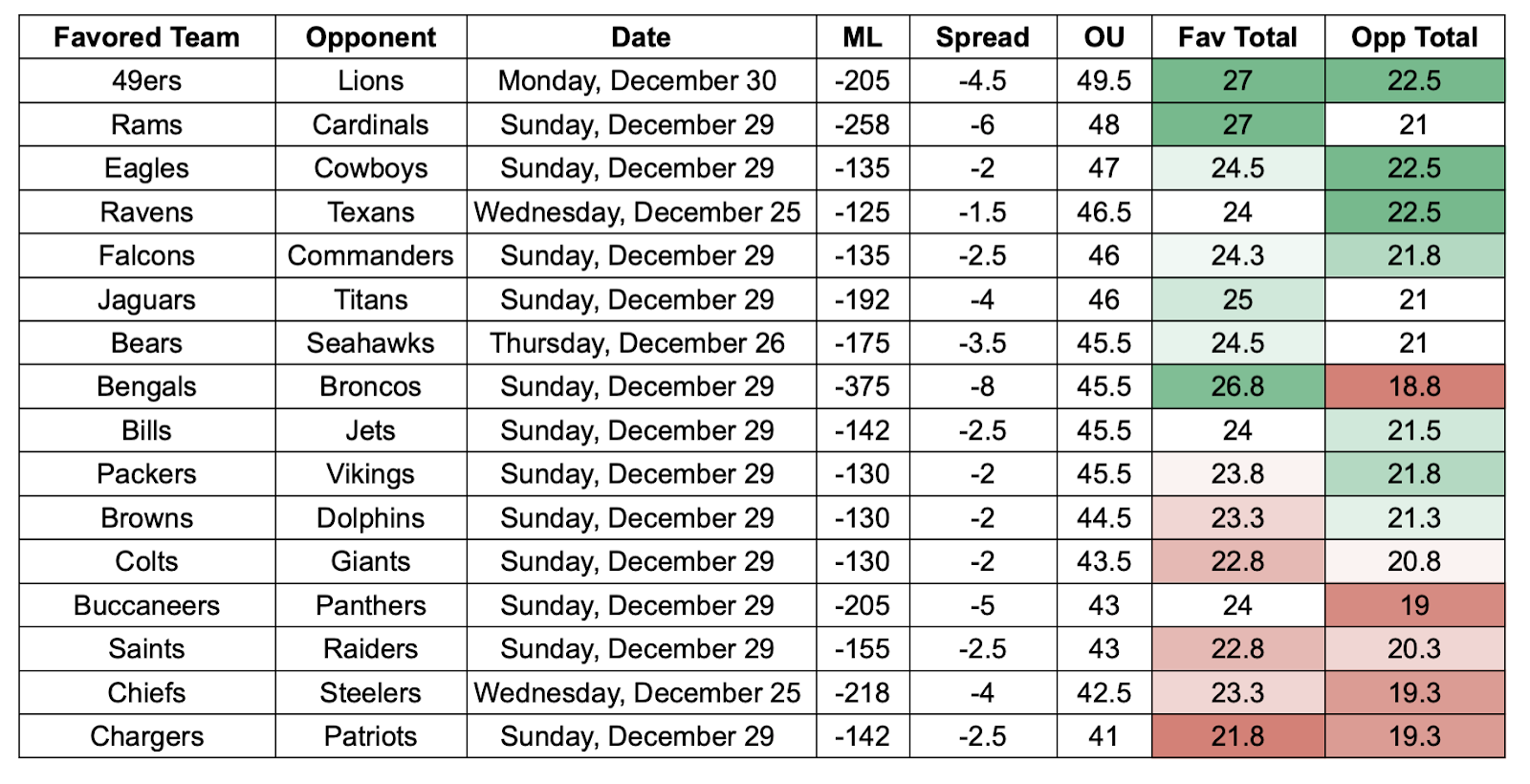
Week 17 Team Implied Totals
Team Stacks – 2024
Best ball ADP will not be like your typical 12-team redraft leagues. Underdog ADP needs to be viewed through the lens of how stacking influences average draft position, especially for quarterbacks.
Detroit Lions
The Lions are second (25.7) ahead of the Chiefs (25.5) in implied points per game by a tiny margin. Combined with the 7th-easiest season-long strength of schedule for QBs and RBs, Detroit is set up incredibly well to continue as a top fantasy offense. The Lions only play three games outdoors all year. Unfortunately, two of those outdoor contests are held in Week 16 (in Chicago) and Week 17 (in San Francisco). As a result, their implied team total during Weeks 15-17 is -1.5 points per game lower than their seasonal average.
Over the last two seasons, Jared Goff averages 21.0 fantasy points per game at home, but that dips to 13.5 FPG on the road. That’s the difference between Goff scoring as a top-5 fantasy QB (at home) and the QB30 on the road.
San Francisco 49ers
The 49ers have a gorgeous playoff schedule during Weeks 15-17 (vs. Rams | at Dolphins | vs. Lions), with the dates against Miami and Detroit set at game totals of 49 O/U or higher. This is all relative because the markets are incredibly high on their offense. Even though they’re projected to score -2.7 fewer points per game on average — which is the fourth-largest dip — San Francisco still has an implied team total of 24.5 in every single game.
Across his 21 regular season starts from 2022-23, Brock Purdy leads all quarterbacks in yards per attempt (9.5) and touchdown rate (7.4%). Even after we factor in projected regression, Purdy might be underpriced at QB13 ADP. He gets the easiest QB playoff schedule (+2.03 FP above average), and the 49ers have the highest implied total in this span (26.3 per game) by nearly a full point ahead of the Bengals (25.5). Christian McCaffrey still has the best TD floor/ceiling in fantasy.
Kansas City Chiefs
After a mediocre season by Patrick Mahomes’ standards, the Chiefs are projected to be the 6th-most improved offense by points per game (+3.7). Getting reinforcements in Xavier Worthy and Marquise Brown is heavily priced in. The best ball markets are all over this, as Mahomes is being selected as the QB4 in ADP. There is no discount in drafts. This is all after Mahomes averaged 23% fewer fantasy points per game last season (18.4) compared to his career norm (23.8 FPG).
The Chiefs are projected to return as a top-3 scoring offense (25.5 implied points per game), which is a little more than a FG worth off of their scoring pace at 28.8 points per game during 2018-22.
Mahomes is due for a big uptick in touchdowns. To start, his touchdown rate last season (4.5%) was easily a career-low and two percentage points off his career rate (6.5%). With better deep threats on the perimeter, we should see Mahomes throw deep more often again. His average depth of target sunk to a lowly 6.7 yards in 2023 – which ranked 36th-of-39 QBs. In his two prior seasons, Mahomes aDOT was a much more normal 7.5 yards downfield.
Dallas Cowboys
The markets have Dallas scoring -5.9 fewer points per game compared to last season, which is the largest point differential overall. Sure, some scoring regression should be expected. This is significant, though. Over the last four seasons, the top-3 scoring teams from the previous season regress by an average of -3.7 points scored per game year-over-year. The only team that was top-3 in scoring the previous season and actually improved year-over-year was the Tom Brady-led Buccaneers (from 2019 to 2020).
Dak Prescott remains a target for the best ball teams with CeeDee Lamb, but this data paints the regression case for Dallas. One thing is for sure: Dak will be behind a significantly less experienced offensive line than in recent seasons, with two new rookies in LT Tyler Guyton and potential new C Cooper Beebe. The good news is that Prescott’s price somewhat reflects the projections – he’s going off of the board at QB9. Dak has finished as the QB11 (or better) in fantasy points per game in six straight seasons.
New York Jets
As expected, the Jets project as the most improved offense year-over-year by a whopping 7.9 points scored per game. New York ranks just outside of the top-12 scoring offenses with 23.7 implied PPG. That’s just marginally ahead of Atlanta (23.6). By Week 1, Aaron Rodgers will be nearly a year removed from Achilles’ surgery.
Garrett Wilson has scored just 7 touchdowns across 34 career games, and that has resulted in mediocre WR36 and WR31 finishes in fantasy points per game. The volume has been strong – Wilson was WR9 in target share (27.1%) last season and WR22 two years ago (22.5%). We just need some scores.
Breece Hall was the RB1 in fantasy when the Jets won (23.7 FPG in seven victories), making him one of the most game-script-dependent running backs last season. For reference, Christian McCaffrey (22.4 FPG) finished as the RB1 by 2.6 FPG over RB2 Kyren Williams (19.8 FPG). Hall was basically a replacement-level FLEX player in losses (8.7 FPG – RB38). Well, things are about to get a whole lot better.
New York is favored in 13 games this year, and that’s tied with the Cowboys, Ravens, and Bengals for third-most. In fact, they’re favored by three or more points in 10 games total. That’s the fourth-most games favored by at least a field goal and behind only the Chiefs (14), 49ers (12), and Ravens (11).
Atlanta Falcons
The Falcons are expected to be the fourth-most improved offense year-over-year by 4.7 implied points per game after finishing 26th in PPG (18.9). The Kirk Cousins effect is fully priced into ADP for Drake London (WR10) and Kyle Pitts (TE6), and rightfully so. Cousins’ worst season of his career in touchdown rate is 4.1%, and that’s still miles better than Desmond Ridder (2.8%).
This boost in touchdown equity is massive for London and Pitts stock. In his first two seasons, London has scored just six TDs on 227 targets (2.6%). Meanwhile, Pitts’ career TD rate is even worse at 2.3% (six TDs on 259 targets). Cousins’ career average TD rate (5.3%) across his nine years as a starter is more than double career rates for his receivers.
We should expect a big uptick in passing volume, too. Atlanta was 31st in pass rate (54%) when the game was within a score, and they were dead last in pass rate (59%) when trailing last season.
Cincinnati Bengals
We can’t wait for Joe Burrow’s return. The Bengals are projected as the sixth-highest scoring offense at 24.8 implied points per game – just barely over their divisional-rival Ravens (24.6). Only the 49ers have a higher implied projection during Weeks 15-17. That’s the good news. The “bad” news is that Burrow has the most difficult strength of schedule among QBs (-0.79 FPG).
Green Bay Packers
Jordan Love and the Packers were absolutely cooking to close out last season. Over their final 12 games (including playoffs), Green Bay scored on 46% of their possessions (second-best) led by Love’s stellar play. During this stretch, Love averaged 20.3 FPG (QB6) and threw for 261.1 yards per game (QB7).
The Packers are correctly getting a ton of respect and have the same exact implied total (24.2 points per game) as the Texans. Additionally, Love gets the easiest strength of schedule in the league (+1.06 FPG) to help boost his ceiling even more. Yet, there is a four-round difference between Love’s ADP (Round 9) and C.J. Stroud (Round 5).
Packers team stacks are undervalued in drafts based on projections. Especially when I take Justin Jefferson in Round 1, I’m teeing up the Packers for all of the Week 17 correlation.
Houston Texans
You’ll have to pay up for Texans stacks with Nico Collins (WR15 ADP), Stefon Diggs (WR18), and Tank Dell (WR26) all priced as strong WR2s. C.J. Stroud is a little bit overvalued relative to other pocket passers – like Joe Burrow and Jordan Love – but his ADP is significantly higher because all of his receivers are taken between 18-40 overall in drafts.
The hype is priced in, the Texans are projected to improve by 2 points per game year-over-year. There is a lot of room for upside here. OC Bobby Slowik’s passing concepts are great – he just needs to call them more. Even with Stroud balling out as a rookie, Houston ranked just 22nd in pass rate when the game was within a score (58%) last season.
Tennessee Titans
The Titans offense offers asymmetric upside in drafts if Will Levis (181 ADP) can take a second-year leap surrounded by improved weaponry. Calvin Ridley and Tony Pollard are the headline additions, but Tennessee’s investments into its offensive line are equally significant. The 7th overall pick LT J.C. Latham joins 2023 first-rounder LG Peter Skoronksi along with veteran addition C Lloyd Cushenberry. Hopefully, the Titans can improve their pass protection after ranking 9th-worst in pressure rate allowed over expectation last season.
Pass-first HC Brian Callahan will spike the Titans pass rate and our projections are significantly higher than ADP on Ridley and DeAndre Hopkins. After the Falcons, the Titans are the second-most likely offense to see a boost in their passing volume after they were 29th in pass rate (55%) in one-score games last season. Connecting on a full team stack with RBs Tyjae Spears (Round 10) or Tony Pollard (Round 9) is incredibly easy.
Just to add a cherry on top, the Titans have the second-easiest strength of schedule for QBs (+0.94 FPG) and the 4th-easiest slate for running backs (+0.5 FPG). Levis will be my most-drafted QB2 in best ball.
Carolina Panthers
The upside case for the Panthers centers around HC Dave Canales elevating Bryce Young after a horrific rookie season. Carolina’s offense was impossible to watch – disjointed, slow, and their receivers were terrible. The main issue stemmed from zero continuity and consistency along the offensive line. Young saw near league-worst protection, with his offensive line giving up a 40% pressure rate (eighth-highest). Carolina has completely uprooted their interior line by spending big on stud G Robert Hunt in addition to C Austin Corbett and G Damien Lewis.
Dave Canales [QB Resume]
— Scott Barrett (@ScottBarrettDFB) May 23, 2024
2020: Russell Wilson hit a career-high in passing touchdowns (by 5) and finished 6 yards shy of a career-high in passing yards.
2022: Geno Smith had started 5 games over the previous 6 seasons, was most famously known for having his jaw broken by a…
Diontae Johnson and Xavier Legette are massive upgrades over D.J. Chark and Jonathan Mingo, but we also have to respect that Canales had two top-25 WR duos of all time in both of his stops in Seattle and Tampa.
By implied totals, we expect the Panthers scoring to progress by 5.7 points per game this season. This is mainly because Carolina’s offense was generationally inept last year. Their 13.9 points per game was the seventh-lowest scoring campaign for any offense since 2010.
It can’t get much worse. Carolina also benefits from great strength of schedule for their passing attack (third-best) and RBs (sixth-best).
New England Patriots
The Patriots were just as inept as the Panthers, with those two teams circling the drain together for the league’s worst scoring output (13.9 PPG). The only way to go is up. By implied totals, we should expect the Patriots scoring to progress by 5.0 points per game.
Drake Maye might not play in Weeks 1-2, but he should absolutely be starting late in the season when having as many “live” players in best ball matters a ton. All of Maye’s receivers are cheap and the Patriots have one of the easiest slates by strength of schedule for QBs (sixth-easiest) and RBs (easiest).
Maye’s standalone rushing upside leaves some room for ceiling in Round 17 of drafts, but I wouldn’t stack up the Patriots with extremely high expectations. New England is projected to score 20 or more points in just four of 16 games during Weeks 1-17, and they’re one of two teams that are not favored in a single game along with the Panthers.
Player Exposure
Balancing roster construction and opportunity cost is at the top of mind when you're drafting teams, but projections are the lifeblood of best ball. Fantasy football always comes down to a few players that really matter.
There were only six players last year who individually boosted your best ball teams’ chances of making the Week 15 playoffs by at least double your “neutral” odds (from 16.7% to (33.4%). Puka Nacua wasn’t even one of them! Last season’s best ball league winners from Weeks 1-14 were Raheem Mostert (43% of teams made playoffs), Dak Prescott (37%), Christian McCaffrey (36%), Kyren Williams (35%), CeeDee Lamb (35%), and Tyreek Hill (35%).
This means that if you ignore the other 17 players you drafted and just focus on the fact that you selected Raheem Mostert in Round 12-13, you had at least a 43% chance of advancing in your league and making the playoffs (in Week 15).
Two years ago, only four players were true league winners with an advance rate of 33% or higher. In 2021, five players hit that threshold. Every fantasy football season has its breakouts and surprises, but there are typically 4-6 players who are true game-changers every year.
Last season, 28 players gave you an individual advance rate to the playoffs that was at least 1.5 times higher (25%) than the odds of an “average” player (16.7%). Here’s the list:
| Player | Pos | Tm | Advance Rate |
| Raheem Mostert | RB | MIA | 43% |
| Dak Prescott | QB | DAL | 37% |
| Christian McCaffrey | RB | SF | 36% |
| CeeDee Lamb | WR | DAL | 35% |
| Kyren Williams | RB | LAR | 35% |
| Tyreek Hill | WR | MIA | 35% |
| Mike Evans | WR | TB | 32% |
| Nico Collins | WR | HOU | 31% |
| Puka Nacua | WR | LAR | 30% |
| De'Von Achane | RB | MIA | 29% |
| Brock Purdy | QB | SF | 29% |
| Keenan Allen | WR | LAC | 28% |
| Tank Dell | WR | HOU | 28% |
| Sam LaPorta | TE | DET | 28% |
| Travis Etienne Jr. | RB | JAX | 28% |
| Alvin Kamara | RB | NO | 28% |
| C.J. Stroud | QB | HOU | 28% |
| Jake Ferguson | TE | DAL | 27% |
| Josh Allen | QB | BUF | 27% |
| Adam Thielen | WR | CAR | 27% |
| Zack Moss | RB | IND | 27% |
| George Kittle | TE | SF | 26% |
| Brian Robinson Jr. | RB | WAS | 26% |
| Rachaad White | RB | TB | 26% |
| Brandon Aiyuk | WR | SF | 26% |
| DJ Moore | WR | CHI | 25% |
| Gus Edwards | RB | BAL | 25% |
| Deebo Samuel | WR | SF | 25% |
We want to maximize our returns for when we get things right. Large-field tournaments offer asymmetric upside just like in DFS, and these advance rates further show the merit of stacking.
Dak Prescott, C.J. Stroud, and Brock Purdy were the three top quarterbacks in the regular season, and all of them had at least two pass catchers with advance rates that were 1.5 times higher than the odds of an “average” receiver.
If a team stack or individual player offers asymmetric upside at ADP – just keep hammering that edge. In theory, diversifying your selections at running back makes sense due to injuries, randomness, and how quickly older players fall off of the Age Curve. Talent matters way more at positions like QB and WR where it’s much easier to outperform ADP with elite efficiency. At running back, we’re really chasing volume and touchdowns.
Luckily for you, we work daily on our projections and best ball rankings. Subscribers can find my rankings here and can upload the rankings set into Underdog with this download.


